|

|
|
Monitoring
and Operations Committee Agenda
NOTICE IS GIVEN that the next meeting of
the Monitoring and Operations Committee will be held in Mataatua Room, Bay of
Plenty Regional Council, 5 Quay Street, Whakatāne on:
Tuesday
3 September 2024 COMMENCING AT 9.30 am
This meeting will be
livestreamed and recorded.
The Public section of
this meeting will be livestreamed and recorded and uploaded to Bay of Plenty
Regional Council’s website. Further details on this can be found
after the Terms of Reference within the Agenda. Bay of Plenty Regional
Council - YouTube
|
|
Fiona McTavish
Chief Executive, Bay
of Plenty Regional Council Toi Moana
26 August 2024
|
|
Monitoring and Operations Committee
|
Membership
|
Chairperson
|
Cr Kevin Winters
|
|
Deputy Chairperson
|
Cr Ron Scott
|
|
Members
|
All Councillors
|
|
Quorum
|
Seven members,
consisting of half the number of members
|
|
Meeting frequency
|
Quarterly
|
Purpose
·
Oversee and monitor the implementation of policies and
strategies, promoting effective delivery and coordination between policy and
implementation through recommendations to the
Strategy and Policy Committee.
·
Monitor the implementation of Council’s
activities, projects and services.
Role
Oversee and monitor:
·
Regulatory performance of permitted activities, resource consents
and bylaw rules, including compliance and enforcement.
·
Delivery of biodiversity, catchment management and flood
protection activities in the region.
·
Delivery of biosecurity activities, including implementation and
monitoring of the Regional Pest Management Plan.
·
Effectiveness of navigation safety bylaw responses.
·
State of the Environment monitoring.
·
Implementation of specific programmes in place such as the Mount
Maunganui Industrial Air Programme, and integrated catchment programmes (e.g.
Rotorua Lakes and Tauranga Moana).
·
Receive information on environmental monitoring
and performance monitoring trends and recommend to the Strategy and Policy
Committee to inform policy review.
·
Monitor Council’s actions on Climate Change.
·
Operational activities that implement relevant national and
regional plans and strategies, including:
§
Science
§ Flood
protection
§ Biosecurity
§ Catchment
management
§ Rivers
and drainage
§ Compliance,
monitoring and enforcement
§ Resource
consents
§
Maritime
Power
to Act
To make all decisions necessary to fulfil the role and
scope of the committee subject to the limitations imposed.
The Monitoring and Operations
Committee is not delegated authority to:
·
Develop, adopt or review strategic
policy and strategy.
·
Approve Council submissions on
legislation, policy, regulations, standards, plans and other instruments
prepared by Central Government, Local Government and other organisations.
·
Identify, monitor and evaluate
necessary actions by the organisation and other relevant organisations under
co-governance arrangements.
Power
to Recommend
To the Strategy and Policy
Committee on matters necessary for reviewing plans, strategies and policies.
To Council and/or any standing committee as it deems
appropriate.
Recording
of Meetings
Please note the Public section of this
meeting is being recorded and streamed live on Bay of Plenty Regional
Council’s website in accordance with Council's Live Streaming and
Recording of Meetings Protocols which can be viewed on Council’s website.
The recording will be archived and made publicly available on Council's website
within two working days after the meeting on www.boprc.govt.nz for a period of
three years (or as otherwise agreed to by Council).
All care is taken to maintain your privacy;
however, as a visitor in the public gallery or as a participant at the meeting,
your presence may be recorded. By remaining in the public gallery, it is
understood your consent is given if your image is inadvertently broadcast.
Opinions expressed or statements made by
individual persons during a meeting are not the opinions or statements of the
Bay of Plenty Regional Council. Council accepts no liability for any opinions
or statements made during a meeting.
Bay of Plenty
Regional Council - Toi Moana
Governance Commitment
mō te taiao, mō ngā
tāngata - our environment and our people go hand-in-hand.
We provide excellent governance when,
individually and collectively, we:
· Trust and respect each
other
· Stay strategic and
focused
· Are courageous and
challenge the status quo in all we do
· Listen to our
stakeholders and value their input
· Listen to each other to
understand various perspectives
· Act as a team who can
challenge, change and add value
· Continually evaluate what
we do
TREAD LIGHTLY, THINK DEEPLY,
ACT WISELY, SPEAK KINDLY, JOURNEY TOGETHER.
Monitoring
and Operations Committee 3 September 2024
Recommendations in reports are not to be construed as Council
policy until adopted by Council.
Agenda
1. Apologies
2. Public
Forum
3. Items
not on the Agenda
4. Order
of Business
5. Declaration
of Conflicts of Interest
6. Minutes
Minutes
to be Confirmed
6.1 Monitoring and Operations
Committee Minutes - 11 June 2024 8
7. Presentations
7.1 Ōtanewainuku Kiwi
Trust – pest animal control work
Presented by: Ross Edwards
7.2 Tauranga
City Council work in response to the Health Risk Assessment
Presented by: Sarah Omundsen - General Manager, Regulatory and
Compliance, Carl Lucca - Team Leader, Urban Communities, Janine Speedy - Team
Leader, City Planning
7.3 Review of the Toi Te Ora
Health Risk Assessment
Presented by: Dr Emily Wilton - Owner,
Environet Limited
7.4 Maritime New Zealand -
Oil Spill Response
Presented by: Graham MacLean - Deputy Chief Executive –
Response, Security and Safety Services and Michael-Paul Abbott - General
Manager, Regulatory Operations
8. Reports
Information Only
8.1 Chairperson's Report 20
Attachment 1 - Mount Maunganui Air
Quality Working Party Q&A 32
Attachment 2 - PM10 24-hour
Averages Table 46
8.2 2023/2024 Compliance
Activity Report 50
Attachment 1 - Sentencing Decisions
Received for 2023-2024 61
Decision Required
8.3 Regional Pest Management
Plan Annual Report for 2023/24 and amended Operational Plan for 2024/25 65
Attachment 1 - Bay of Plenty
Regional Pest Management Plan - Operational Plan 2024-2025 FINAL DRAFT 70
Attachment 2 - 5499 RPMP Ops Plan
Annual Report 2023-24 FINAL DRAFT 122
8.4 Implementation of the
Flood Protection and Drainage Bylaws 2020 208
Attachment 1 - Bylaw Applicable
Areas 216
Information Only (Continued)
8.5 Environmental Code of
Practice for Rivers & Drainage Maintenance Activities - 2023-2024 Annual
Review 218
Attachment 1 - Table of completed
R&D Operations works 2024 224
Attachment 2 - Complaints Register 225
Attachment 3 - Hapu/Iwi Resource
Management Plans 226
8.6 District Consent
Applications Annual Report 2023/24 228
9. Consideration
of Items not on the Agenda
Monitoring and Operations Committee
Open Minutes
Commencing: Tuesday 11 June 2024, 9.30 am
Venue: Mataatua Room, Bay of Plenty Regional Council Toi Moana (BOPRC),
Level 1, 5 Quay Street, Whakatāne and via Zoom (Audio-Visual meeting)
Chairperson: Cr Kevin Winters
Deputy Chairperson: Cr Ron Scott
Members: Cr Stuart Crosby
Cr Toi
Kai Rākau Iti (via Zoom)
Chairman
Doug Leeder
Cr
Matemoana McDonald
Cr Jane
Nees
Cr
Lyall Thurston (via Zoom)
Cr
Andrew von Dadelszen (via Zoom)
Cr Te
Taru White (via Zoom)
Cr
Malcolm Campbell
Cr Ken
Shirley
In Attendance: Fiona McTavish – Chief Executive, Namouta Poutasi –
General Manager, Strategy and Science, Mat Taylor – General Manager,
Corporate, Chris Ingle – General Manager, Integrated Catchments, Reuben
Fraser – General Manager, Regulatory Services, Presenters – as listed
in the minutes, Amanda Namana – Committee Advisor
Apologies: Cr Paula Thompson, Cr Kat Macmillan
1. Apologies
|
Resolved
That the Monitoring and Operations
Committee:
1 Accepts
the apologies from Cr Thompson and Cr Macmillan tendered at the meeting.
Scott/Campbell
CARRIED
|
2. Declaration of Conflicts
of Interest
None declared.
3. Minutes
Minutes to
be Confirmed
|
3.1
|
Monitoring and Operations
Committee Minutes - 5 March 2024
Matters Arising
In relation to
Minute Item 4.3 Kaituna Re-Diversion and
Maketū Estuary, it was noted that a public meeting had been scheduled
for 6pm, Tuesday 18 June 2024 at Maketū Community Centre. This was
to be co-led by BOPRC staff, community board staff and local iwi - an invitation
to the event would be sent to members.
|
|
|
Resolved
That the Monitoring and Operations Committee:
1 Confirms
the Monitoring and Operations Committee Minutes - 5 March 2024 as a true and
correct record.
Scott/Campbell
CARRIED
|
4. Presentations
|
4.1
|
Land Optimisation for Fresh
Water Quality Restoration
Presentation: Land optimisation for fresh
water quality restoration: Objective ID A4697822
Presented by: Alison Dewes and John
Burke
|
|
|
Key Points:
· New
Zealand farmers were facing significant pressures and change within a short
timeframe
· Recommended
that members read the Kerry Warsnop paper on designing agricultural policy
for a future in farming: The mountain we need to climb: Kerry Warsnop - February 2024.
9.45 am – Cr Matemoana McDonald entered
the meeting.
· Unprecedented
levels of challenges were ahead, overlayed by climate change effects
· Outlined
global risks by category and ranked by severity over the short and long term,
including the biggest challenges these created for low-lying areas
· Highlighted
the scale of the problem for heavily impacted estuaries in the region
· Explored
land use transition and noted that 58% of farms in the catchment alone had
unlined ponds
· Noted
that good management practices would not be enough to resolve the issues
· Food
systems were exerting significant pressures on the environment
· Farmers
desired straight-forward, clear messaging to ensure correct interpretation
and action, particularly for regional plans, policies and rules
· Moving
forward, consumer pressure and catchment groups working with regional
councils and tangata whenua would be required to assist farmers in moving
forward with agility and pace
· Described
a ‘market ready farm’ as one that could be handed down to future
generations as well as being market ready for global and trade partner
requirements
· Animal
numbers across coastal Bay of Plenty and dairy farms were declining due to a
range of pressures on farmers
· Considered
that the calculator used for dairy effluent compliance did not take into
account additional weather events, nor the higher frequency of saturated
soils
· Highlighted
the importance of aligning what the market required with regional council
planning and requirements. Outlined the actions regional councils
needed to take to better support land use change at catchment scale
· Developing
a landscape plan for catchments was critical, along with looking ahead to
understand the requirements for land use change in the long term, including
considering climate change and sea level rise to achieve objectives
· Farmers
required economic incentive to assist in land use change.
Key Points - Members:
· Congratulated
John Burke for recently being recognised with the Cawthron National
Freshwater Champions award
· Building
strong relationships would play an important part in moving forward, as would
fostering inter-generational change
· It
was important to look at the overall macro-economic drivers facing the
country, rather than the problem in isolation.
In Response to Questions:
· Considered that early adopters of nitrogen trading arrangements
were not always rewarded as expected
· E coli was the most readily available proxy for councils to test
for pathogenic bacteria in the environment with minimal waste, however this
was a somewhat crude option for testing as there were many bacteria it did
not pick up
· Bacteria lived in sediments and formed biofilms on the sediment
which required more frequent testing and over a longer period of time
· Clarified that the detail in the slide referring to 58% of dairy
effluent ponds being unlined should have referred to 58% of farms in the
catchment not up to ‘best management practice’ when looked at in
2016, a component of which included unlined ponds. Many of the consents
needed to be brought up to ‘good management practice’ by 2025.
Staff clarified that our approach is to require effluent systems to be
upgraded when consents expire and replacement consents are sought.
|
|
4.2
|
Maritime New Zealand Oil
Spill Response Capacity
|
|
|
The Chair advised that this presentation would be
deferred to a future meeting to accommodate the availability of presenters.
|
5. Reports
|
5.1
|
Chairperson's Report
Presentation: Cutwater Road wetland
restoration new approach: Objective ID A4697823
Presentation: He Rāhui Herenga Waka
Whakatāne Site: Objective ID A4697819
Tabled Document 1 - Letter to Iwi and Councils
- Rainbow Mountain Renewable Energy: Objective ID A4698160
Presented by:
Reuben Fraser – General Manager, Regulatory Services and supported by
staff listed below.
Cutwater
Road Wetland Restoration – Pim de Monchy,
Coastal Catchments Manager and Braden Rowson, Team Leader, Coastal Catchments
Key Points:
· Provided a concept redesign update which included 20 hectares of
coastal wetland and 10 hectares of treatment wetland
· Current costings for this option remained approximately the same
as costs in the Long Term Plan
· This option would achieve the primary objective of cleaning up the
estuary by reducing contaminant load
· Fish passage options would need to be considered
· Outlined the benefits and disadvantages, and the next steps.
In Response to Questions:
· The water would likely remain in the wetland for three to four
days. The low-lying nature of the land meant that the water volume was
manageable and consistent throughout the year
· Considered this was a good option which responded to the
challenges of water quality and climate change adaptation
· The proposal was to retain the stopbanks around the land,
isolating it from tidal flows
· Some enhancement planting was planned to achieve the outcomes.
He
Rāhui Herenga Waka Whakatāne Site - Pete
McLaren, Compliance Contractor and Fraser Toulmin, Compliance Team Leader,
Land Use
Key
Points:
· Barriers to getting the project underway that were within
BOPRC’s control were:
o Certification of the last
site and soil contamination management plan
o Finalisation and payment
of the bond, for which the final amount needed to be recalculated by
assessing the risk through the management plan. The terms of the bond
agreement had been agreed by all parties
· Provided a history of the site and Soil Containment Management
Plan
· Containment Site 3 (CS3) was BOPRC owned
· The consent was granted by the Environmental Protection Authority
(EPA) in June 2022 and BOPRC staff requested more work be undertaken due to
suspecting further contamination at the site
· Whilst dioxins were present at trace levels throughout most of the
site, results of testing showed levels in the northern side were high enough
that the waste could not be left in place, nor could it be put outside of a
secure, contained area. The source of this was different from the
majority of waste onsite and likely came from Pinex sawmill waste in the
1980s
· The developer’s proposal was that available space in CS3 be
used for the containment of this waste. BOPRC policy was that any
additional waste would require a change to the consent
· The site included material dredged from Kopeopeo Canal and staff
did not want to risk interference with bioremediation efforts already
underway, although noting that the risk was small
· Dioxins were persistent chemicals that did not break down but did
bind strongly to sediment and organic matter
· Perfluoroalkyl
and Polyfluoroalkyl Substances (PFAS) were present across site in low
concentrations but caused large concerns and posed the risk of potentially
contaminating other sites in future.
In Response to Questions:
· The bond was able to be reviewed annually and there was a separate
bond for Stage 1 and Stage 2
· The wood waste was proposed to be dug out and stockpiled on Stage
3 before being sorted
· Clarified that the bond was in place to ensure compliance with the
consent, not to complete remediating the site
· The material that the wood had been treated with in the old Pinex
sawmill was Pentachlorophenol (PCP) and dioxin was present in this as a trace contaminant
(by-product)
· The groundwater which interacted with the Whakatāne River was
known to be contaminated, however levels of contamination in the river were
unknown
· The developer’s disposal site options were not known but
would require consent.
11.17 am –
The meeting adjourned.
11.30 am –
The meeting reconvened.
Chairperson's Report
(Continued)
Key Points - Members:
· Requested staff report back on the Environmental Protection
Authority (EPA) decision to extend the use of methyl bromide.
In Response to Questions:
· Toi Te Ora commissioned a health risk assessment relating to air
quality in Mount Maunganui. The report had findings around the impact
of air quality on people’s health and BOPRC, along with Tauranga
City Council would like to use these findings in planning and resource
consent decisions. The EnviroNet report in the agenda was commissioned
to provide certainty around the reliability of the data and approach used -
staff would request the author, Emily Wilton speak at a future meeting
· Generally ‘low risk non-compliance’ referred to
something that was not having an acute environmental effect e.g. irrigator
calibration (technical non-compliance for records not being sent through)
· Farmers’ input was required to complete compliance audits,
inspections were generally held at the same time of year and usually with 24
- 48 hours’ notice
· Abatement notices in the Rotorua airshed were issued to landlords
in the first instance for permitting the activity. There was a good
response from landlords quickly replacing the home heating to resolve the
issue
· There was a National Institute of Water and Atmospheric Research
(NIWA) low-cost sensor project currently underway in Rotorua and BOPRC staff
had clarified that all conditions of the contract would be fully met, despite
upcoming staff redundancies throughout the NIWA organisation. Staff
would draft a letter to NIWA seeking confirmation of this, to be signed by
the Committee Chair
· The issue that the Ballance infringement notices were issued for
related to a standard stack test carried out on the manufacturing plant and a
sulphur dioxide breach was identified which exceeded their consent limits.
The issues have been resolved and compliance has been achieved subsequently
· The pollution hotline continued to receive many calls regarding
odour in the Mount Maunganui industrial area, noting that these were often
not able to be substantiated.
|
|
|
Resolved
That the Monitoring and Operations Committee:
1 Receives
the report, Chairperson's Report.
Winters/Crosby
CARRIED
|
Information
Only
|
5.2
|
Maritime Operations Summer
Initiatives
Presentation: Maritime Team Update: Objective
ID A4697821
Presented by: Jon Jon Peters -
Bay of Plenty Harbourmaster
Key Points:
· Dealing
with abandoned and derelict vessels held its own challenges due to the legal
ramifications
· The
focus for summer would include the eastern areas of the region
· The
maritime Safer Boating campaign finished with 1.2M impressions, with Facebook
being the main awareness driver
· The
fatality rate on the water of those not wearing lifejackets was three times
higher than people who did, stand up paddleboard users had been noted as the
least compliant
· Less
activity on the water during summer had been noted across the country
compared to previous years
· Provided
nationwide Safer Boating Survey statistics and noted that taking a way to be
able to call for help when heading out on the water was critical
· MV
Achilles bulker ship came close to running aground on 24 July 2023 due to
steering failure caused by loss of its rudder. Due to the serious
navigational risk posed, a Harbourmaster Direction was issued to the ship,
subsequently the ship was arrested via a court order which the
Harbourmaster used to carry out the arrest by the court officers.
Key Points - Members:
· Noted
the signage for jetskis at Ōhiwa Harbour needed to be clearer and the
Harbourmaster confirmed changes were pending following the new navigational
safety bylaws being adopted.
In Response to Questions:
· The
source of the recent oil spill had still not been determined, with a
suspected ship being examined.
|
|
|
Resolved
That the Monitoring and
Operations Committee:
1 Receives
the report, Maritime Operations Summer Initiatives.
McDonald/Campbell
CARRIED
|
|
5.3
|
Climate Change Quarterly
Report
Presented by:
Nic Newman – Climate Change Programme Manager
Key Points:
· A community-led adaptation project was underway across the Eastern
Bay of Plenty, focusing on Opape, Tōrere and Maraenui to assist in
planning for community readiness in terms of climate change and extreme
weather events
· Initial discussions were underway with community leaders at Lake
Rotoehu and Lake Rotomā around how council could potentially support
future adaptation
· Whakatāne District and Tauranga City Councils were planning
to undertake global risk assessments for climate change, which would assist
in building upon regional risk assessments
· Outlined initial results from NIWA regarding blue carbon samples
taken, however the full report was yet to be received
· The Regional Energy Transition Accelerator (RETA) project was
complete and local businesses could use the information regarding
opportunities for energy transition from this for forward planning.
Staff were also undertaking work in the Tauranga geothermal field
· The Western Bay of Plenty circular economy project looked at
construction waste and identified opportunities in this space going forward.
In Response to Questions:
· The Bay of Plenty had been chosen by the Aotearoa Circle due to
the size of the region, the available data from work already undertaken,
along with having an engaged community.
|
|
|
Resolved
That the Monitoring and
Operations Committee:
1 Receives
the report, Climate Change Quarterly Report.
Crosby/Leeder
CARRIED
|
|
5.4
|
ICM Swimmability KPI and Land
Management Action
Presentation: ICM Swimmability KPI and Land
Management Action: Objective ID A4697817
Presented by: Jackson Efford -
Principal Advisor, Land and Water and James Dare – Environmental
Scientist, Water Quality
Key Points:
· Highlighted the different mitigations funded by BOPRC for
environmental and water quality outcomes (within council’s sphere of
influence)
· The wider the buffer (e.g. riparian setbacks), the greater the
contamination removal that could be achieved
· Treatment wetlands and detainment bunds had been proven to have
highly successful outcomes in contamination reduction, although they were
expensive to build
· For the Key Performance Indicator (KPI) the current methodology
used was ‘Table 9’ from the National Policy Statement for
Freshwater Management (NPS-FM), as when it was first established this was the
only table that considered faecal contamination
· Both the ‘average’ method (69.6% of sites deemed
swimmable) and the ‘worst’ method (39.1% sites deemed swimmable)
were currently being used for reporting
· Noted that sites often failed on the 95th percentile
statistic (rainfall events). Proposed a new approach involving a
rainfall threshold for each of the sites, which separated rainfall affected
results from non-rainfall affected results. This would
also be a more reflective output of land management activity (potential to
detect ‘improvements’ at baseflow as a result of the mitigations
funded)
· The new approach was being reviewed externally, as well as by
auditors before being adopted into the Long Term Plan (LTP)
· Utuhina drinking water at Pukehangi Road was in poor condition
despite its proximity to Karamu Takina Spring, as the upper Utuhina catchment
was a mix of pastural and forestry with a separate source which was not
hydraulically connected to the spring.
Key Points - Members:
· It was important to continue to be able to track short and long
term trends to analyse going forward
· Cautioned over drawing a correlation between integrated catchment
management initiatives and rainfall data without understanding the intensity,
duration and geology.
In Response to Questions:
· General advice was to not swim if the water was turbid or within
48 hours following rainfall, however different catchments responded
differently to rainfall events and this had been taken into consideration
during analysis
· Agreed protocol came from the microbiological water quality
guidelines and the National Policy Statement for Freshwater Management
(NPS-FM)
· Both sets of data would be reported with the new approach, however
targets would be set with the rainfall-removed analysis
· The Ohau channel was one of the sites deemed to be not heavily
affected by rainfall and the classification came from the NPS-FM Table 22
· Noted the complications involved in pulling the different data
sources together
· The swimmability KPI had changed several times since it was
developed due to changes in the NPS-FM, and the new methodology sought to
address this.
|
|
|
Resolved
That the Monitoring and
Operations Committee:
1 Receives
the report, ICM Swimmability KPI and Land Management Action .
McDonald/Crosby
CARRIED
|
12.33 pm – Cr
Shirley withdrew from the meeting.
|
5.5
|
Findings from NIWA's
'Doubling on-farm diffuse pollution mitigation programme'
Presentation: Doubling on-farm diffuse
pollution mitigation programme overview: Objective ID A4697999
Presented by: Dr Chris Tanner (via
Zoom)
|
|
|
Key Points:
· Outlined
the specific research aims of the ‘Interceptor Project’
· Five
interceptive mitigations included riparian buffers, woodchip bioreactors,
filamentous algal nutrient scrubbers, constructed wetlands and detainment
bunds
· Grass
filter strips were particularly effective in removing fine sediment, however
planted zones with deeper roots helped remove nutrients from shallow
groundwater and provided more ecological benefits
· Ideally,
the width of the riparian buffer needed to change depending on how much
catchment up-slope would drain to it
· Woodchip
filters were suitable for treating nutrients in tile drainage with low
sediment loads and aimed to provide an organic carbon source that slowly
released
· Outlined
work undertaken and findings from carbon dosing field trials
· Provided
phosphate concentration results from modifying wood chips
· Filamentous
algae from nutrient scrubbers (FANS) could be put back on farmland as a slow
release fertiliser and had potential for other uses. There were three
different operation modes being trialled, a performance comparison with
constructed wetlands and full-scale harvest methods
· Detention/detainment
bunds were most relevant for upland areas with more rolling country where
sediment associated contaminants were important
· Explained
the key contaminant removal process for surface-flow constructed wetlands and
how runoff flow paths were intercepted
· Each
mitigation method provided different benefits and mitigated a range of
contaminants
· Te
Rere Maniatutu wetland was 1.9 hectares and received inflow from surface
drainage and groundwater. Summarised findings to date of contaminant concentration
reduction through monitoring data
· Monitoring
needed to be completed over a period of time to ensure the full spectrum of
flow events was captured
· Outlined what was needed to accelerate implementation including
rules and policies that promoted rather than inhibited uptake.
In Response to Questions:
· Water at Te Rere Maniatutu wetland remained an average of two to
three days, fluctuating to three to four hours during large weather
events.
Resolved
That the Monitoring and
Operations Committee:
1 Receives
the presentation, Findings from NIWA's 'Doubling on-farm diffuse pollution
mitigation programme'.
Campbell/Scott
CARRIED
|
|
5.6
|
Rates Collection Status
Update
Presented by: Jo Pellew – Rates
Manager.
|
|
|
Resolved
That the Monitoring and
Operations Committee:
1 Receives
the report, Rates Collection Status Update.
Crosby/McDonald
CARRIED
|
1.38 pm – the meeting closed.
Confirmed
Cr Kevin Winters
Chairperson, Monitoring and Operations Committee
|
|

|
|
|
|
Report To:
|
Monitoring
and Operations Committee
|
|
Meeting
Date:
|
3
September 2024
|
|
Report
Authoriser:
|
Reuben Fraser – General
Manager, Regulatory Services
|
|
|
|
|
Executive Summary
This report provides an update on key matters of interest for
Monitoring and Operations Committee members including:
· Regulatory
Compliance
· Resource
Consents
· Mount
Maunganui Industrial Air
· Rotorua
Air Quality Programme
|
Recommendations
That the Monitoring
and Operations Committee:
1 Receives the report, Chairperson's Report.
1. Purpose
The report provides an update on key matters of interest
for Monitoring and Operations Committee members.
2. Matters
of Potential Interest
2.1 Regulatory
Compliance Update
The agenda of
this Monitoring and Operations Committee meeting contains a report on
Compliance Activity during the 2023/34 year. The update below outlines the key
enforcement matter of interest since that period.
On 17 July 2024
Council received Judge Dickey’s sentencing for Bay of Plenty Regional
Council v Badala Orchard Limited, Baygold Limited and P3 Earthworks Limited.
The case related to earthworks undertaken to recontour land for the development
of a kiwifruit orchard on Ōtamarākau Valley Road. Works were not
undertaken in accordance with their resource consent and the failure of a
poorly constructed sediment retention pond resulted in sediment laden water
discharging from the site (see photo overleaf).
Badala Orchard
Limited as the consent holder were charged and convicted for a breach of
s15(1)(b) of the Resource Management Act, by discharging sediment laden
stormwater which may have resulted in the contaminant entering water. Her
Honour took a $35,000 starting point (we had sought $50,000 and Badala sought
less than $30,000). This was influenced by the professional advice Badala had
taken from Stratum, Baygold and to a lesser extent P3. Her Honour found that
Badala’s conduct was careless given the number of non-compliances on
site. The end sentence was a fine of $24,500 for Badala.
Baygold Limited
and P3 Earthworks Limited were charged and convicted for contravening s9(2) of
the Resource Management Act by undertaking earthworks in contravention of the
conditions of the resource consent.
Baygold Limited
were contracted by Badala to undertake the full development including
regulatory management, earthworks, orchard construction and planting of the
site. Judge Dickey took a starting point of $35,000 (which was higher than the
$20,000 we sought and much higher than the $10,000 Baygold had argued for). She
held that Baygold’s culpability was higher than P3’s due to it
being the head contractor. She rejected Baygold’s application for discharge without conviction and agreed with our
point that their evidence did not identify how much of the
‘remediation’ cost was actually remediation and how much was repair
of the pond. She did acknowledge that their cooperation and efforts to address
the damage went beyond what is normally seen in these cases and gave them
additional credit for this. The end sentence was a fine of $22,750 for Baygold
Limited.
P3 Earthworks
Limited were engaged by Baygold Limited to carry out the earthworks on site and
constructed the sediment retention pond that failed. Judge Dickey agreed with
our starting point of $20,000 and settled on a final fine of $14,000.
This was a
complex case that involved a number of different parties, and the outcome is
the result of some great work done across the whole compliance team including
our in-house legal Counsel Hayley Sheridan who represented Bay of Plenty
Regional Council on this matter.

2.2 Resource
Consents Update
2.2.1 Consents
of Interest
These are the key consent matters of interest in the period
since the last Committee meeting in June 2024.
Following the consent hearing for Ballance’s
discharge to the harbour (Mt Maunganui) the applicant has consulted with Ngati
Kuku on conditions for a short-term consent. The consent is expected to be
granted in the next three weeks.
Updates on the Covid-19 Fast-track process applications
which were lodged with the Environmental Protection Authority last year:
· Taheke Geothermal proposal for a geothermal power station
– the panel has sought further information again from the applicant
regarding aviation safety.
· Summerset Retirement Village Rotorua, Fairy Springs Rd
– a panel has still not been formed.
· Pitau multistorey retirement village at Mt Maunganui
– granted.
· Ngongotahā residential development – the panel
have sought comments from the various parties regarding draft conditions of
consent.
A joint hearing with Western Bay of Plenty District Council
on the Te Puna Industrial Ltd consent application was held in July 2024. The
commissioners have sought additional information from the applicant.
The Te Huata marine farm application is still on hold at
the applicant’s request. An associated consent has been granted for eight
two hectare research sites off the coast of Te Kaha.
Resource consent has been granted to Southern
Generation’s application to remove debris islands and dredge the
Rangitāiki River upstream of Lake Aniwaniwa to alleviate flooding.
The consent granted to Eco-Rakau forestry for works to
divert the Wainui Stream in Tōrere for the purpose of reinstating a
Māori roadway has been appealed.
The appeals for the Ōpōtiki marina consent have
been resolved through mediation and staff expect to be able to provide an
update on Genera appeals during the meeting.
Tauranga City Council’s Tauriko West comprehensive
stormwater consent application has been publicly notified. Eleven submissions
have been received.
Ecocast’s resource consent application to expand
their existing vermicomposting activity in Kawerau has been notified and five
submissions were received.
2.2.2 Legislative
Changes
The
Select Committee have released their report on the Extended Duration of Coastal
Permits for Marine Farms Bill. The report maintains much of the original
proposal to extend marine farm consents by 20 years or 2050 (whichever occurs
first), for the cost of any consent condition reviews to be borne by councils
and councils needing to obtain permission from the Director General of MPI.
Several
other changes to resource management law are also being progressed by the
government and consents staff have been engaging with various ministries on
potential changes. Some current proposals in the early stage of development
include:
· Changes to s107 and s70 of the RMA (relates to discharge
consents).
· Changes to consenting for renewable energy generation and
wood processing.
· Changes to the New Zealand Coastal Policy Statement.
· Changes to the National Environmental Standards (NES) for
Marine Aquaculture.
· Extending the duration for port occupation consents.
· Changes to the RMA and creation of new regulations for
municipal wastewater.
· Changes to the RMA regarding interface with the Fisheries
Act.
2.3 Mount
Maunganui Industrial Air Update
The Mount Maunganui Airshed (MMA) was gazetted as a
polluted airshed under the National Environmental Standards for Air Quality
(NESAQ) Regulations 2004, coming into effect in November 2019. The gazetting
was based on breaches of the limits for fine particulate matter, PM10. As per
the regulations, five continuous years with no NESAQ PM10 breaches must be
recorded for the polluted status to be reviewed.
This report covers the period from May to early August 2024
and covers the range of activities and teams involved in working to minimise
the impacts of air pollution in the Mount Maunganui Airshed (MMA). A quarterly
newsletter was distributed in July.
2.3.1 PM10
monitoring and exceedances in the current financial year
Whilst year on year
the number of PM10 breaches recorded has shown a reducing trend, we have yet to
record a 12-month period since the airshed was gazetted with no breaches of the
NESAQ regulations. In the 2023/24 financial year, three breaches of PM10
standards were detected (one permitted under the legislation). These were all
location specific and able to be attributed to activities occurring near a
monitoring location. In each case, the cause was an activity creating a dust
discharge being undertaken within a few meters of the monitoring site. These
breaches are not symptomatic of widespread dust pollution across the entire
airshed but more indicate how localised activities can impact on our monitoring
data.
In these cases,
we have worked with the business / industry involved to ensure they continue to
undertake appropriate dust suppressant measures when work is being undertaken.
Additional
monitoring has been implemented in the Mount Maunganui airshed and surrounding
residential areas to detect benzene levels in the atmosphere. These passive
monitors are intended to be in place for an initial period of 12 months and are
in direct response to recommendations in the Toi Te Ora / ESR Health Impacts
Study report.
2.3.2 Air
Quality Monitoring Programme Changes
Introduction
Running an ambient air quality monitoring network comes at
a significant cost (about $500,000 per year to meet requirements of both the
Mount Maunganui and NERMN networks), therefore Council regularly assesses this
network to ensure it provides valuable information.
Council staff recently assessed the air monitoring network
and made changes to ensure it was fit for current and future needs. This
modified monitoring programme was used in the development of the contract with
Watercare Services Ltd for undertaking monitoring over the next 3-year period
of the Long-Term Plan.
This section provides a summary of the changed state of the
new monitoring programme.
Historical MMA Programme
The bulk of the
MMA monitoring programme was established in late 2018 (Whareroa Marae started
in 2015) and initially ring-fenced the Port of Tauranga, which was believed to
be the main source (or sources) of particulates.
The programme consisted of six monitoring
sites in the Tauranga area that complied with the monitoring requirements of
the NESAQ. A range of contaminants were measured across these sites, including
particulates (TSP, PM10 and PM2.5), sulphur dioxide, total reduced sulphur,
hydrogen sulphide, nitrogen oxides and meteorological parameters.
Several additional sites also
measured monitor volatile organic compounds but are not discussed in this
report as they are not related to NESAQ.
Revised
MMA Programme
Council now has a continually growing
and improved understanding of particulates in the area and as a result are
adjusting the monitoring coverage accordingly. At a high-level, adjustments
have been driven by a combination of:
· necessary
levels of knowledge being established,
· a
shift towards industry funded monitoring sites for compliance with Rule
AREA2-R1 (the interim permitted activity rule or IPAR),
· developing
improved understanding of the impacts on air quality in the residential areas
surrounding the Airshed.
A map showing the location of the modified
programme monitoring sites, and contaminants monitored is below, see Figure 1.
Primary Changes:
a. Three monitoring sites have been removed:
· De
Havilland Way previously measured PM10
but was removed in July 2023. This monitor experienced a number of false
positives (periods of elevated data values) due to a truck-wash being located
only a few metres away. The monitor will likely be replaced with an industry
funded monitoring site for compliance with Rule AREA2-R1 (the interim permitted
activity rule or IPAR). A lower cost Clarity indicator site has been
established near this location to continue to provide coverage in this area of
the Airshed.
· Rail
Yard South was previously monitoring PM10.
In late 2022 a sinkhole opened up next to the shelter housing the monitoring
equipment necessitating its removal. A replacement site called Totara Street
Rail Crossing is now in place 110 metres to the northeast of the Rail Yard
South site.
· Sulphur
Point has fulfilled its purpose of providing
information on particulate and sulphur dioxide levels in the area and has been
replaced by a lower cost Clarity indicator site.
b. Two new
sites have been established:
· Totara
Street Rail Crossing replaces the Rail Yard South
site and is located on the roadside reserve land across from Dominion Salt on
Totara Street. It monitors particulate (TSP & PM10) and sulphur dioxide.
· Ranch
Road is a new residential ‘super site’,
installed in 2024 and will shortly be monitoring particulates (TSP, PM10
and PM2.5), sulphur dioxide, oxides of nitrogen and volatile organic
compounds. This site is located on Council reserve on the northern boundary of
Mount Maunganui College and Ōmanu School and close to dwellings. It is not
within the designated bounds of the airshed but acts as a representative for
the receiving residential community in that area.
c. Some
changes at existing sites are also being implemented:
· Whareroa
Marae and Rata Street will measure the finer PM2.5
particulate contaminant. This smaller, more harmful fraction of particulates,
which has been the topic of further conversation following the central
government proposed changes to the NES-AQ and the updated WHO guidelines, is a
necessary component of current and future ambient air quality monitoring
programmes. Council will monitor this contaminant to ensure that robust and
relevant data (not only for the Mount Maunganui area, but also the Rotorua Airshed)
is available for planning and management of air quality within the region.

Figure 1 Current Mount Maunganui Airshed (MMA)
monitoring programme.
Overall, the adjustments to the Mount Maunganui monitoring
network address future requirements with monitors being positioned and calibrated
for a range of additional contaminants that may be detected.
A table of the PM10
24-hour averages is included as Attachment 2.
2.3.3 Mount
Maunganui Air Quality Working Party
A second meeting of the Mount Maunganui Air Quality Working
party for 2024 was held on 17 June, which was the last to be attended by
Tauranga City Council commissioners. The meeting focussed on future plans for
the air-shed with several presentations by BoPRC and TCC staff on activities
and projects planned to positively impact on improving air-quality. There were
several questions from Working Party members surrounding the Toi Te Ora Health
Impacts Study and the subsequent review undertaken by Dr Emily Wilton,
Environet Ltd. Dr Wilton will be presenting and available for questions during
this Committee meeting.
We are pleased to announce that Paul Cooney, retired
partner of Cooney Lees Morgan Lawyers, has been appointed as the independent
chair of the Air Quality Working Party. Paul will be chairing his first hui of
this group when it next convenes again on 10 October.
Staff presented at a community meeting about air quality in
Mount Manungaui, hosted by Clear the Air. Dr Jim Miller of Toi te Ora, Sarah
Omundsen of Tauranga City Council and Joel Ngātuere of Whareroa Marae also
spoke at the event which approximately 140 people attended, including
Councillor Scott. Questions from attendees were captured during the evening and
those questions and their answers are included as Attachment 1.
2.3.4 Pollution
Hotline Complaints Response
From 1 May to 30 July 2024, 78 service requests were
received through the Pollution Hotline relating to air quality within the MMA.
The majority of these service requests related to odour.

Figure 2: Mount Airshed Service Request Types
Odour from the
two asphalt plants in the Mount Industrial area continue to be an issue for the
community with 31 of the 69 complaints (45%) reporting bitumen smells.
All urgent calls
were responded to within 12 hours and non-urgent calls responded to within
three working days.
One breach of the
Resource Management Act 1991 (RMA) was confirmed in relation to a
discharge of offensive and objectionable odour from Greenmount Foods beyond the
boundary of its site. Greenmount Foods is located on Jean Batten Drive and is a
food manufacturing facility cooking sauces, stocks, broths, and gravy for both
domestic markets and export. An abatement notice was served in response to this
breach, requiring CSI Foods Trading Limited, trading as Greenmount Foods, to
cease discharging contaminants, namely offensive and objectionable odour, to
air beyond the boundary of its site.
2.3.5 Odour
and pro-active monitoring
In response to community concerns staff have changed and
improved the approach to monitoring of the two asphalt plants located within
the airshed.
Allied Asphalt and Higgins notify pollution response staff
of all plant start-ups, batch volumes and expected running times. The team then
assess this against meteorological data to estimate potential odour plumes. If
it is likely that an odour plume will drift in the direction of the residential
area and/or schools, a compliance officer will, when possible, proactively
patrol the receiving environment and assess any odours detected.
This also means that an officer will already be in the
airshed and able to respond rapidly to any complaints of bitumen odour.

Figure 3: Example of BOPRC meteorological data (showing
south-west wind direction) overlaid on map to estimate odour plume; blue dots
on map represent asphalt plant locations.
Proactive monitoring during this period has not resulted in
any non-compliance or confirmed breaches of the RMA being identified.
For now, staff have ceased proactive monitoring of the
wider airshed and will re-evaluate this decision when the summer ‘odour
season’ begins. The team will continue to respond to reports of odour
received via the Pollution Hotline.
2.3.6 Consents
There are several applications that
are currently being processed in the Mount Maunganui area and new applications
are anticipated following recent Court decisions. A summary of where in the
process each of the applications are at, is outlined below:
Allied
Asphalt
Allied Asphalt have applied for a new
consent for their site in the Mount Maunganui industrial area. The proposal is
to install a new plant in the Mount which is proposed to reduce emissions. An
Environment Count hearing was held on 13 – 17 May 2024. A decision from
the Environment Court has not been received to date.
Genera Limited
The consent granted to Genera Ltd for
the discharge fumigants (methyl bromide, phosphine and Ethanedinitrile (EDN))
to air was appealed on 27 October 2023 by Clear the Air Trust and Tauranga
Fumigant Action Group. Ngāti Kuku joined the appeal as a Section 274
party. Court assisted mediation between the parties took place on 28 February
2024. A judicial conference was held with Judge Kirkpatrick on 23 April 2024.
The Judge agreed to allow time for the appellants to engage experts to review
the application and proposed conditions. A second conference was held on 26
June 2024 with Judge Smith where it was decided that expert witness and planner
conferencing would be held. Planner conferencing has been undertaken to
refine the proposed conditions.
Lawter NZ Ltd
The application for discharge to air
was publicly notified on 17 November 2023. Forty-seven submissions have been
received and a hearing date was set for 9-10 September 2024. However, the
hearing date has been postponed, subject to a request under Section 91 for an
application for consent under the National Environmental Standards for Green
House Gas Emissions from Industrial Process Heat 2023.
WM New Zealand (Waste Management)
Still awaiting further information
requested.
The Port of Tauranga
The Environment Court has issued an
Interim Decision in relation to the Port of Tauranga (POTL) Stella Passage
proposal which relate to different parts of the overall proposal for the
extension of the wharfs and dredging of the channel. An interim Court Decision
has granted consent for Stage 1 of the Sulphur Point wharf extension subject to
certain provisions being met to the satisfaction of the Court. Sulphur Point
Stage 2 and the Mount wharf extension has not been granted at this stage. A
reconvened hearing is envisaged once further information requested has been
provided and the adverse cultural effects on Whareroa Marae have been
addressed.
The
applications and technical documents for all notified applications can be found
on the BOPRC Website: www.boprc.govt.nz/environment/resource-consents/notified-applications-submissions-and-hearings/notified-applications
2.3.7 Interim
Permitted Activity Rule (IPAR) Dust Management Plans
As part of the Interim Permitted Activity Rule (IPAR)
outlined in Plan Change 13 (PC13 – Air Quality), qualifying activities
undertaken in the Mount Maunganui airshed were required to submit a dust
management plan to the Bay of Plenty Regional Council by 12 August 2024.
This is intended to reduce the amount of dust discharged to air and follows the
Environment Court finding that poor air quality is negatively impacting the
health of residents.
Ten dust management plans have been submitted, with a
further two outstanding. These dust management plans require that a dust
monitoring programme is established, and any exceedances are advised to
Regional Council along with an investigation report containing corrective
actions.
2.3.8 Policy
Matters
The release of the interim Environment Court decision for
the PC13 appeal and the need to ensure consistency within the Regional Natural
Resources Plan means there has been no change to the development of the
high-level framework of provisions for Plan Change 18 – Mount Maunganui
Airshed (PC18). However, the interim PC13 decision has given Council staff
direction on the likely final form of the s293 provisions to inform PC13, which
will in turn shape the approach to PC18.
This third interim decision is to be
treated as the final findings of the Court and the rules are deemed to be
operative. The Final Decision will only be issued after the s293 process on
unsealed yards is finalised which is expected in October. This decision brings
into effect an interim permitted activity rule for three years (ending 11
February 2027) for Bulk Solid Material (BSM) handling. All BSM operators within
the Mount Maunganui Airshed are expected to apply for a Certificate of
Compliance (CoC) in relation to this rule in the interim and apply for a
consent prior to the end of the interim permitted activity period.
2.4 Rotorua
Air Quality Programme Update
2.4.1 2024
Rotorua Airshed winter enforcement of Airshed rules on non-complying solid fuel
burners
Compliance staff will continue
this field work into September. The figures below are abatement/infringement
notices served per property address (not per individual) to date.
|
Year
|
Abatement Notices
served
|
Infringement Notices
served
|
Warning Letters
served
|
|
2022
|
33
|
0
|
0
|
|
2023
|
52
|
5
|
2
|
|
2024
|
38
|
10
|
0
|
|
TOTALS
|
123
|
15
|
2
|
NOTE:
Abatement Notices not associated with resource consents do not incur fines or
costs (but remain in-place and current).
Staff engage with owners to
progress compliant heating. If an owner-occupier is unable to fund replacement
heating, and they qualify for EECA’s Warmer Kiwi Homes funding, the
Regional Council funds the 20 percent top-up. Each property is assessed on a
case-by-case basis.
Infringement notices (fines) are
served for repeated use of a non-complying burners. Some property owners
won’t engage with staff until they receive an infringement notice.
2.4.2 Rotorua Airshed
Ground-truthing of Dispersion Modelling (PM2.5, PM10)
A network of Clarity low-cost indicator sensors has
been installed across the Rotorua Airshed. At a later stage Regional
Council’s Science team will update councillors on the results and
modelling of the data.
Attachments
Attachment 1 - Mount Maunganui Air Quality Working Party Q&A ⇩
Attachment 2 - PM10 24-hour Averages Table ⇩
Monitoring
and Operations Committee 3 September 2024














Monitoring and Operations
Committee 3 September 2024




|
|

|
|
|
|
Report To:
|
Monitoring
and Operations Committee
|
|
Meeting
Date:
|
3 September
2024
|
|
Report
Writer:
|
Matthew Harrex, Compliance Manager -
Land and Water and Stephen Mellor, Compliance Manager - Air, Industry &
Response
|
|
Report
Authoriser:
|
Reuben
Fraser, General Manager, Regulatory Services
|
|
Purpose:
|
This report updates the committee on
key achievements within the Compliance activity for the 2023/2024 Year.
|
|
|
|
2023/2024
Compliance Activity Report
|
Executive Summary
This report presents a summary
of the compliance activity for the 2023/2024 year. It presents a summary of the
consent compliance monitoring undertaken over the year, results of the
permitted activity monitoring programme, an update on enforcement action and
a summary of our pollution response activity.
|
Recommendations
That the Monitoring and Operations Committee:
1 Receives the report, 2023/2024 Compliance Activity Report.
1. Introduction
The Bay of
Plenty Regional Council (Regional Council) uses a variety of regulatory and
non-regulatory tools to manage the environmental impacts of activities throughout
the region, including rules made and resource consents issued under the
Resource Management Act 1991 (RMA). Compliance with the requirements of these
rules and resource consents provides an important measure of how we, as a
regulatory authority, engage with the community to manage environmental
impacts. This report provides a summary of Regional Council’s compliance,
monitoring and enforcement activity through the 2023/2024 year.
1.1 Legislative Framework
The Regulatory
Compliance function operates as a core council requirement under the Resource
Management Act; which sets out an obligation for Regional Councils to monitor
and enforce compliance with the Act and any associated instruments (e.g.
National Environment Standards), Regional plan rules and resource consents.
There is some crossover with other legislation through activities such as
incident response and enforcement proceedings.
On 24 August
2023 the Natural and Built Environment Act 2023 (NBA) came into effect. While
many provisions of the NBA would not have come into effect until a new plan was
developed under the act, there were some provisions in relation to compliance
monitoring and enforcement that came into effect on the 24 August 2023:
• Offending that
occurred post 24 August 2023 was subject to increased penalties to $1 million
(from $300,000) for individuals and to $10 million (from $600,000) for
companies.
• Defendants
could not elect trial by jury as the maximum prison sentence was reduced to 18
months.
• Abatement
notices could be used to require preventative action to be taken.
• There
was wider scope to recover costs for permitted activity monitoring and
compliance.
However, four
months later (23 December 2023) the Natural and Built Environment Act 2023 was
repealed and the provisions of the Resource Management Act 1991 applied again.
The four provisions outlined above were lost at that time. There was an impact
on the compliance activity from preparing for and implementing new legislation
and then reverting to previous provisions. Several of our prosecution cases
crossed over this period adding additional levels of complexity. From a budget
perspective the scope to recover costs for permitted activity monitoring and
compliance was reduced.
Staff continue
to operate in an environment of change to our legislative framework as the
intent and direction of the current government is being implemented. While this
is not expected to have a significant impact on the work we currently deliver,
it will require us to be adaptive and responsive to changes to the overarching
legislation and national direction.
1.2 Alignment with Strategic
Framework
|
A Healthy Environment
|
We
manage our natural resources effectively through regulation, education and
action.
|
|
Freshwater for Life
|
We collaborate
with others to maintain and improve our water resource for future
generations.
|
|
The Way We Work
|
We
provide great customer service.
|
1.2.1 Community Well-beings Assessment
|
Dominant Well-Beings Affected
|
|
þ Environmental
High -
Positive
|
þ Cultural
Medium
- Positive
|
þ Social
Low -
Positive
|
þ Economic
Low -
Positive
|
2. Compliance Monitoring
2.1 Overview
Compliance
monitoring is an important tool for ensuring that consent holders and members
of the public are undertaking activities in the correct manner and complying
with the conditions of any applicable resource consents, Regional Plan rules,
and/or National Environmental Standard (NES) provisions.
Consented
activities are monitored through a combination of site inspections and
performance monitoring, which involves the review of data and reporting
provided by consent holders.
The frequency
for site inspections is determined according to a range of factors, including
the nature, scale, and environmental risks associated with the activity. This
frequency is reviewed annually and outlined in Council’s RMA and Building Act Charges Policy.
The frequency
for performance monitoring is considered during the consent application process
and set out in the conditions of a resource consent.
2.2 2023/2024 Compliance
Monitoring Results
Note:
2022/2023 results shown in brackets.
Throughout
2023/2024 there were 8,421 (8,442) active resource consents across Toi
Moana. Regional Council undertook 4,437 (3,572) site inspections and
reviewed 16,741 (13,761) performance monitoring returns from consent holders
across 4,437 (4,439) consents.
Compliance
results for site inspections showed that 62% (77%) were complying with their
consents, and only 2% (1%) were in significant non-compliance. This is still 75
instances of serious compliance issues. While full compliance is down from last
year (77%) we have only seen a slight increase in significant non-compliance
occurrences. Compliance remains relatively consistent with numbers seen in
previous years and across other regions.
Performance
monitoring generally related to the assessment of data or reports provided to
us by the consent holder. A large proportion of these are monthly checks on
water metering data, but this also includes a range of other activities such as
geothermal takes, discharges to air, land and water. Of the 16,741 (13,761)
performance monitoring returns assessed, 78% were found to be compliant, which
is down 3% on 2022/23. Part of this is attributed to staff providing closer
checks on reporting conditions while on site. The largest category of
non-compliance was considered to be low risk (11%). There was an increase in
significant non-compliance up to 60 (0.4%) from 55 (0.4%), this is still down
from the 144 for the 2021/2022 year. Over 50 of these significant
non-compliances relate to water take consents conditions such as consistently
not providing records, not verifying water meters and records showing excess
takes. Addressing significant non-compliances has resulted in some consent
holders applying to vary their consent for the correct amount of water
required, some taking action to remedy the situation by fixing infrastructure
or reducing takes, or for the more serious or difficult customers service of an
abatement or infringement notice.
The most
monitored activities were water takes, earthworks, dairy effluent discharges,
and on-site wastewater system discharges. This is consistent with previous
years and reflects both the environmental risks associated with these
activities, and the volume in which they occur within Bay of Plenty Region. A
number of other activities, such as major infrastructure and industrial
facilities, can also present a significant risk and are inspected regularly;
however, these are fewer in number, and often have a more significant reliance
on performance monitoring.
Table 1: 2023/2024 Compliance Results for High
Risk/Priority Activities – site inspections and performance monitoring.
|
Activity
|
Total inspections
|
Complying
|
Low Risk Non-Compliance
|
Moderate Non-Compliance
|
Significant Non-Compliance
|
|
#
|
%
|
#
|
%
|
#
|
%
|
#
|
%
|
|
Dairy
|
314
|
194
621
|
62%
|
68
|
22%
|
36
|
11%
|
16
|
5%
|
|
Discharges to air
|
328
|
286
|
87%
|
25
|
8%
|
8
|
2%
|
9
|
3%
|
|
Earthworks
|
951
|
834
|
88%
|
70
|
7%
|
40
|
4%
|
7
|
1%
|
|
Forestry
|
92
|
77
|
84%
|
10
|
11%
|
5
|
5%
|
0
|
0%
|
|
Geothermal
|
1,335
|
1,093
|
82%
|
150
|
11%
|
73
|
5%
|
19
|
1%
|
|
OSET
|
1,133
|
586
|
52%
|
371
|
33%
|
170
|
15%
|
6
|
0.5%
|
|
Water Takes
|
11,717
|
10,104
|
86%
|
1,152
|
10%
|
404
|
3%
|
57
|
0.5%
|
|
Discharges to land or water
|
1,837
|
1,391
|
76%
|
314
|
17%
|
117
|
6%
|
15
|
1%
|
Onsite Wastewater Effluent
Treatment (OSET) (48%) and Farm Dairy Effluent (38%) had the highest proportion
of non-compliance over the year.
A third of OSET assessments
undertaken found low risk non-compliance. Most of this non-compliance is
attributed to management and maintenance issues such as not pumping out tanks
within the required timeframe or not connecting to Territorial Authority network
when it becomes available. An example of this is a consented OSET accommodation
facility in Waihi Beach had a condition to connect to the WBOPDC wastewater
network when available. The condition resulted in the expiry of the consent
when WBOPDC installed a wastewater line at the boundary of the accommodation
facility. An abatement was issued requiring them to connect to the network. The
facility owner has applied for a connection consent with WBOPDC.
Examples of significant non-compliance include constant exceedance of discharge
volume consent limits or ponding discharges of wastewater.
Significant non-compliances remain
a low proportion of total assessments for most activities. For our high risk
and priority activities Farm Dairy Effluent had the highest proportion of
significant non-compliances (5%). The nine significant non-compliance
incidences for air discharges were attributed to four consent holders, one of
which is within the Mount Maunganui airshed, and one in the Rotorua airshed.
Levels of compliance are relatively consistent to what was found throughout the
2022/23 year. Earthworks (88%), Discharge to Air (87%), Water Takes (86%),
Forestry (84%), and Geothermal (82%) all had compliance levels above 80%.

2.3 Permitted
Activity Monitoring
2.3.1 Permitted Activity Water Takes
The
permitted activity team did a desktop assessment to identify sites that either
had a bore and/or were a horticultural property without a water take consent
likely to need water for irrigation. 238 properties were identified that
warranted an inspection. Compliance was checked against 84 of those during the
irrigation season of December 2023 and March 2024. The purpose of the
monitoring was to ensure compliance with permitted activity rules relating to
the take and use of surface and groundwater water, including ancillary
activities such as drilling bores.
Staff inspected all aspects of
the water take and irrigation system to check compliance with specific
permitted activity conditions during their visits. This included understanding
infrastructure capacity, water use demand, and taking water meter readings.
Staff provided education to water users to ensure they were aware of permitted
activity standards and when to apply for a water take resource consent.
Of the 84 sites inspected 13
were found to exceed permitted activity limits which were mostly made up of
volume breaches, rate of take breaches, or use of geothermal water. The
permitted activity monitoring program and increased presence in the community
has raised the level of compliance and awareness of water use rules. This is
reflected in the absence of significant formal enforcement action required for
the 2023-24 season compared to five prosecutions carried out in previous years.
A small portion of water users
are unaware of water use rules or have opted to use water in breach of water
use rules. This has resulted in staff serving six infringement notices and five
abatement notices for exceeding permitted limits. Our team took the opportunity
to engage with Zespri to raise water compliance issues and identify ways to
support better compliance.
Twenty-eight permitted activity
sites have been consented as a result of this inspection programme. This means
there is an additional 1,135,437m3 per year of water now managed by
the resource consenting regime.
2.3.2 Permitted Activity On-Site Wastewater
Treatment Systems
Staff assessed 66 sites in
relation to their on-site effluent treatment system (OSET). The purpose of the
inspection is to assess the scale and nature of any wastewater discharge and
overall risk to the environment. Staff inspected property files from the
Territorial Authorities to determine location and dimensions of existing OSET
systems, as well as carrying out site inspections to check compliance against
the OSET plan performance standards and permitted conditions. This included
staff understanding building and drainage drawings, wastewater generation rates
across a range of activities, and assessing wastewater land application fields
to ensure waste is disposed without creating any adverse environmental or
health effects. Sites inspected range from rural wedding venues, packhouses and
Ministry of Education schools.
Of the 66 sites inspected 32
were found to exceed the OSET plan permitted activity limits mainly due to
wastewater discharge volume breaches or ponding of wastewater in the land
application area. Seven sites suspected of exceeding permitted activity limits
were assessed as complying with the OSET plan after inspection and 14 sites
remain under assessment. The exceedance of permitted activity limits has
resulted in staff serving four abatement notices and one infringement notice.
Nine OSET sites have applied for
and received an OSET resource consent because of this inspection programme.
This means these sites will have a fit for purpose wastewater discharge system
that meets environmental and health standards. One example is the Faith Bible
College (Tauranga Harbour catchment) which has spent approximately $500,000 to
upgrade their system from failing soak holes and septic tanks to a modern
treatment and disposal system. Four sites have connected to Territorial
Authority wastewater reticulation networks.
2.3.3 Permitted Activity Earthworks
Bay of Plenty Regional Council
checked compliance against 15 permitted activity earthworks sites. These sites
include cleanfill[1]
disposal sites and recontouring of horticultural properties. Staff have worked
proactively with industry to ensure proposed permitted activity sites can and
will comply with permitted activity conditions. Staff inspected the earthworks
sites to ensure the areas of exposed soil complied with the area limits of the
Regional Natural Resources Plan and adequate erosion and sediment controls had
been installed. This was achieved by mapping the extent of earthworks sites and
assessing erosion and sediment controls against the applicable guidelines to
ensure they will minimise the discharge of sediment from the sites.
All sites inspected complied
with the permitted activity conditions during the 2023/24 assessment period.
Staff consider this is a result of proactive communication to industry
outlining what is required to comply with earthwork rules and potential consequences
of non-compliance.

2.3.4 Interim Permitted Activity Rules
As part of the Interim Permitted
Activity Rules (IPAR) outlined in Plan Change 13 (Air Quality), qualifying companies
in the Mount Maunganui airshed were required to submit a dust management plan
to the Bay of Plenty Regional Council by 12 August 2024. This is intended
to reduce the amount of dust discharged to air and follows the Environment
Court finding that poor air quality is negatively impacting the health of
residents.
At the time of writing (20
August 2024) 10 dust management plans have been submitted, with a further two
still outstanding. These dust management plans require that a dust monitoring
programme is established, and any exceedances are advised to Regional Council
along with an investigation report containing corrective actions.
3. Service Requests
Service requests received via
the pollution hotline were slightly up on last year (2%) with a total of 2,384
service requests received. On average that is more than six service requests
every day of the year. A third of service requests were received after hours.
93% of all service requests were actioned in less than 24 hours. 23% of service
requests were substantiated to confirm a breach of the RMA, NES, a regional
rule or a consent.

Figure 3: Service requests
received for the last seven years.
67% (1,596) of all service
requests were related to air quality, over 700 service requests were for odour
and over 600 were for smoke. In the Mount Maunganui Industrial
area, the team has seen a shift from pet food odours and dust complaints to
predominantly odour complaints associated with bitumen production. Both bitumen
facilities are currently looking to update their plant which ultimately should
help with service request numbers. Until the new facilities are in place the
team continue to proactively monitor sites in the Mount Maunganui Industrial
area[2].

Figure 4: Word cloud
of service requests by topic for the 2023/2024 year.
The majority of service requests
were for the western part of our region, 66% of service requests were for the
Tauranga City and Western Bay of Plenty rohe, then an even split of 17% each in
Rotorua and Eastern Bay of Plenty. These figures are roughly in line with the
population distribution within the Bay of Plenty.

Figure 5: Service
requests received by Territorial Authority.
4. Enforcement
In 2023/2024
Regional Council received decisions from the court in relation to 10 matters
resulting in $442,750 in fines and 150 hours of community service. Staff follow
a rigorous process to determine the appropriate enforcement response in
accordance with our Enforcement Policy. As of 1 July 2024 there were five other
cases before the courts[3]. A summary of prosecution decisions is provided in Appendix 1.
Regional Council issued 216 (217
in previous year) abatement notices, and 96 infringement notices (85 in
previous year), totalling $64,000 in fines. There has been a slight increase in
the number of abatement and infringement notices issued this year.
· 71
abatement notices and 29 infringement notices were issued for non-compliance
with resource consents.
· 145
abatement notices and 30 infringement notices were issued to address
non-compliance with a rule in our plan or a national environmental standard.
· The
majority of abatement and infringement notices related to Section 15 offences
(discharges of a contaminant).
5. Considerations
5.1 Risks and Mitigations
The compliance function operates
in a number of high-risk areas, both in terms of environmental risk
(particularly through the incident response function), and legal risk through
the enforcement function. Regional Council has a number of robust systems and
policies in place to manage and mitigate these risks.
5.2 Climate Change
The matters
addressed in this report are of a procedural nature and there is no need to
consider climate change impacts.
5.3 Implications for Māori
The Māori population in the
Bay of Plenty equates to about 28% of the total population. BOPRC has clear
statutory obligations to Māori under the Local Government Act 2002 (LGA),
and the RMA. In particular, Part 2, Sections 6 and 7 of the RMA recognise and
provide for participation in decision-making, having regard to kaitiakitanga,
consultation and fostering development.
Tangata whenua, as kaitiaki,
seek to protect the natural and physical environment, waahi tapu and other
sites of cultural significance to ensure community and cultural sustainability
is achieved. This aligns closely with the goals of compliance monitoring and
enforcement and is considered in the day-to-day implementation of our
compliance programme.
In practical terms, this may
include ensuring tangata whenua are notified of incidents in their rohe beyond
the initial abatement notices or infringements ("no surprises"
approach) and seeking involvement in projects where appropriate (eg. marae
wastewater). Staff are also more actively looking into opportunities to form
partnerships to support shared goals and outcomes. Staff are also working
closely with relevant iwi and hapū to understand and articulate the
effects of significant non-compliance on tangata whenua to better describe the
environmental and cultural harm caused.
5.4 Community Engagement
|

|
Engagement with the community is not required as the
recommended proposal / decision [relates to internal Council matters only].
|
5.5 Financial Implications
There are no material unbudgeted financial implications and
this fits within the allocated budget.
The Compliance budget is funded from general rates,
resource consent fees and charges (a mix of fixed annual fees and charges,
actual and reasonable costs recovered from consent holders) and infringement
fees and fines. Resource consent holders are charged for compliance monitoring
costs as set out in our Fees and Charges Policy.
$2,306,000 or about 30% of the Compliance Budget this year
was funded through a combination of fees and charges from resource consent
monitoring and income from fines and infringements. This was boosted
significantly as a result of the 10 prosecution decisions we received this
year. Utilising in-house legal services continues to result in significant
financial savings ($230,000 compared to budget).
The total operating expenditure for the for the compliance
team was $7,028,000. Savings were made this year by reducing our spend on
contractors and consultants.
6. Next Steps
The Regulatory
Compliance group will continue to implement process improvements to ensure that the compliance monitoring programme is
implemented effectively and efficiently. Similarly, staff are continuing to
hone data over time to provide avenues for more proactive approaches to
encouraging compliance. With a new coalition Government who have signalled
changes to national direction there is uncertainty around what the future
legislative framework will look like. However, we are prepared and agile to
respond to changes that may come over the horizon.
Attachments
Attachment 1 - Sentencing Decisions Received for 2023-2024 ⇩
Monitoring
and Operations Committee 3 September 2024




|
|

|
|
|
|
Report To:
|
Monitoring
and Operations Committee
|
|
Meeting
Date:
|
3
September 2024
|
|
Report
Writer:
|
Greg Corbett, Biosecurity Manager and
Romany Prevette-Stanaway, Biosecurity Dive Technician
|
|
Report
Authoriser:
|
Chris
Ingle, General Manager, Integrated Catchments
|
|
Purpose:
|
To seek the Committee’s
approval for the Regional Pest Management Plan Operational Plan 2024/25 and
present the 2023/24 Annual Report.
|
|
|
|
Regional
Pest Management Plan Annual Report for 2023/24 and amended Operational Plan for
2024/25
|
Executive Summary
The
Biosecurity Act 1993 requires the preparation an annual report on the
implementation of the Regional Pest Management Plan for the Bay of Plenty
Region 2020-2030 (RPMP). It also requires that Council reviews, and if
appropriate amends, the Operational Plan for the RPMP each year.
The RPMP
Operational Plan has been amended to reflect Council’s newly adopted
Long Term Plan and associated budgets. Section 2 of this report summarises
the 2024/25 Operational Plan, which is attached for the Committee’s
consideration and approval.
Section 3 of
this report summarises the 2023/24 RPMP Annual Report, which is also attached
for the Committee’s information.
|
Recommendations
That the Monitoring
and Operations Committee:
1 Receives the report, Regional Pest Management Plan Annual Report for
2023/24 and amended Operational Plan for 2024/25;
2 Approves the 2024/25 Operational Plan for the Bay of Plenty Regional
Pest Management Plan.
1. Introduction
This paper
presents the Bay of Plenty Regional Pest Management Plan 2020-2030 (RPMP)
Annual Report for 2023/24. It also presents an Operational Plan for the 2024/25
year for the Council’s approval.
1.1 Legislative
Framework
The Biosecurity
Act requires Council to provide regional leadership for pest management within
its region (section 12B). Council delivers this role through the Biosecurity
Activity within its Long Term Plan (LTP), which includes implementing the RPMP.
The RPMP became
operative on 17 December 2020. Council’s Monitoring and Operations
Committee subsequently approved an Operational Plan to implement the RPMP.
Section 100B(1)
of the Biosecurity Act requires that the RPMP Operational Plan be reviewed
annually and amended if necessary. The Operational Plan has been amended to
reflect Council’s new LTP and funding available to deliver individual
pest programmes.
Section 100B(2)
of the Act requires progress on Operational Plan delivery is reported annually.
This report must be provided to Council and then made publicly available.
1.2 Alignment
with Strategic Framework
|
A Healthy Environment
|
We
develop and implement regional plans and policy to protect our natural
environment.
|
|
Freshwater for Life
|
|
|
Safe and Resilient Communities
|
|
|
A Vibrant Region
|
|
|
The Way We Work
|
We look
to partnerships for best outcomes.
|
By delivering the RPMP Council aims to
protect our natural environment from the most harmful pests threatening our
region. In doing this work we look to partner with landowners, community, and
other organisations for mutual benefit.
1.2.1 Community
Well-beings Assessment
|
Dominant Well-Beings Affected
|
|
þ Environmental
High -
Positive
|
þ Cultural
Medium
- Positive
|
þ Social
Medium
- Positive
|
þ Economic
High -
Positive
|
Pests can threaten our natural environment, regional
economy, cultural values and affect how we lead our lives. Reducing or
preventing the impacts of pests on these values are key drivers for the
Biosecurity Activity and the RPMP. Secondary benefits of our pest management
work include local employment and improving the connection of communities to
their local environment.
2. Regional
Pest Management Plan Operational Plan 2024/25
The Monitoring and
Operations Committee approved the original RPMP Operational Plan on 9 March
2021. The Biosecurity Act requires that this Plan be reviewed annually and, if
necessary, amended. Staff have reviewed the Plan and made minor amendments to
reflect Council’s new LTP budgets and known third-party contributions for
the Biosecurity Activity.
The amended Plan is attached to this report for the
Committee’s consideration and approval.
3. Regional
Pest Management Plan 2023/24 Annual Report
The Annual Report
2023/2024 is attached for the Committee’s information.
Overall, good
progress towards achieving RPMP objectives is being achieved with the number of
programmes determined to be ‘on-track’ (90%) exceeding Council Long
Term Plan goal for 2023/24 of 85%. One exclusion pest (Rudd) has been detected
in the Matata lagoon through eDNA sampling and the feasibility of local
eradication is currently being assessed.
Part One of the
report highlights the number of collaborative programmes and partnerships the
biosecurity activity delivers. Collaboration and partnership is a strength of
the programme and shared decision making and operational delivery allows for
better alignment between agencies and partners and more efficient and effective
pest management.
While 10 of the 15
eradication plants had a reduction in infestation area, overall eradication
pest plant cover has increased compared to last year due to new infestations of
Sagittaria being found. No hornwort was detected in Lake Ōkataina or Lake Ōkareka - demonstrating good progress towards local
eradication. Six eradication species remained at zero density, which again shows
good progress towards eradication from the region.
No ground hunting
for feral goats within the Goat Eradication area occurred last year due to the
application of 1080 across 120,000 hectares of the Raukumara Ranges by the
Raukumara Pae Maunga Restoration Project. Much of this year’s effort (123
hunter days) focused on the buffer area along the boundary of the eradication
area to prevent goats spreading into the area.
Marine biosecurity
surveillance over the last year resulted in three fewer Mediterranean fanworm
sites compared to the previous year, and no clubbed tunicate were found. Further
development of the Marine Vessel Portal - a shared marine biosecurity data
management system - has meant that the results from surveys of vessel hulls and
pontoon lengths and piles can now be accurately reported.
The LTP goal for 2023/24 relating to
eliminating wallaby ‘satellite populations’ was not achieved. The
goal measures progress towards eliminating the seven satellite populations
known to be present outside the Containment Area. Of the seven populations, two
are considered eliminated and another two are at zero density i.e., no
wallabies (or only a single wallaby confirmed remaining) detected in the last
three years. Surveillance at another site that was reported at zero density
last year, discovered evidence of wallaby presence again this year.
Overall, there was a reduction
in infestations of most pest plants within progressive containment areas, though
there are still challenges with some species, particularly wild kiwifruit and
woolly nightshade. Council’s new pest plant data management system, Geopest, has allowed
for improved reporting, showing trends in pest plant infestations, which helps
staff to identify where increased effort is needed.
Partnering with Māori is one of
Council’s strategic priorities and continues to be a focus for the
biosecurity activity. Examples are partnering with Te Arawa Lakes Trust to
manage aquatic pests, including catfish, and supporting Ruawāhia 2B Trust
to deliver wildling pine control on Mount Tarawera. The ‘Working with
communities’ case study highlights collaborative ways of working on the
East Coast. Council continued to collaborate with iwi contractors and
landowners to control a range of pest plants that are present within the Te
Whānau ā Apanui rohe. In 2023-2024, the programme worked with
landowners across 97 properties.
4. Considerations
4.1 Risks
and Mitigations
There are no
significant risks associated with this matter.
4.2 Climate
Change
The matters
addressed in this report are procedural and while there is no need to consider
climate change impacts, generally pest management activity has positive effects
for climate change, in particular the control of browsing animal pests such as
wallabies.
4.3 Implications
for Māori
Māori
generally have a strong interest in managing pests through their kaitiaki role
and are increasingly involved in the delivery of the RPMP mahi. Collaboration
continues with Te Arawa Lakes Trust to manage the catfish programme, undertake
boat ramp inspections and manage aquatic pest plants (and more recently gold
clam prevention). Strong relationships have been built, or maintained with hapū
on Matakana Island, Te Whānau a Apanui and with Ruawāhia 2B trust who
affiliate with Ngāti Rangitihi. These relationships are mutually
beneficial and more opportunities will be investigated moving forward.
4.4 Community
Engagement
|

|
INVOLVE
Whakaura
|
To work directly with affected communities throughout
the process to ensure that their issues and concerns are consistently
understood and fully considered in Council’s decision making.
|
One of the aims of Council’s
biosecurity Activity is to increase the effectiveness pest management carried
out by our communities and landowners. We do this by providing technical
advice, best practice guidelines and look to engage in community events to
inform and educate on key biosecurity issues e.g. Woolly Wipeout campaign.
4.5 Financial
Implications
If the recommendation is adopted by Council,
will it result in:
- Unbudgeted work during the current financial
year?
- Unbudgeted work for any of the years remaining
in the current Long Term Plan?
If the answer is ‘no’ to
both questions please select the dropdown option 1 and complete appropriately.
If the answer is ‘yes’ to either
question please select “Budget Implications” in the building block
below and liaise with your Management Accountant in order to complete the
Financial Impact table.
There are no
unbudgeted financial implications and the operational plan fits within the
allocated budget for the current LTP year.
5. Next
Steps
Next Steps: What next? What resources are
needed? Further analysis? Timeframes ahead. Any consultation planned. Remind
Council of the process ahead. Next update to Council?
Conclusion: Short concluding remarks. Referring
back to recommendations. No new content.
The amended RPMP Operational Plan will be implemented,
assuming it is approved by the Committee, along with other pest management work
supported through Council’s LTP.
Attachments
Attachment 1 - Bay of Plenty Regional Pest Management Plan -
Operational Plan 2024-2025 FINAL DRAFT ⇩
Attachment 2 - 5499 RPMP Ops Plan Annual Report 2023-24 FINAL DRAFT ⇩
Monitoring
and Operations Committee 3 September 2024





Monitoring and Operations
Committee 3 September 2024

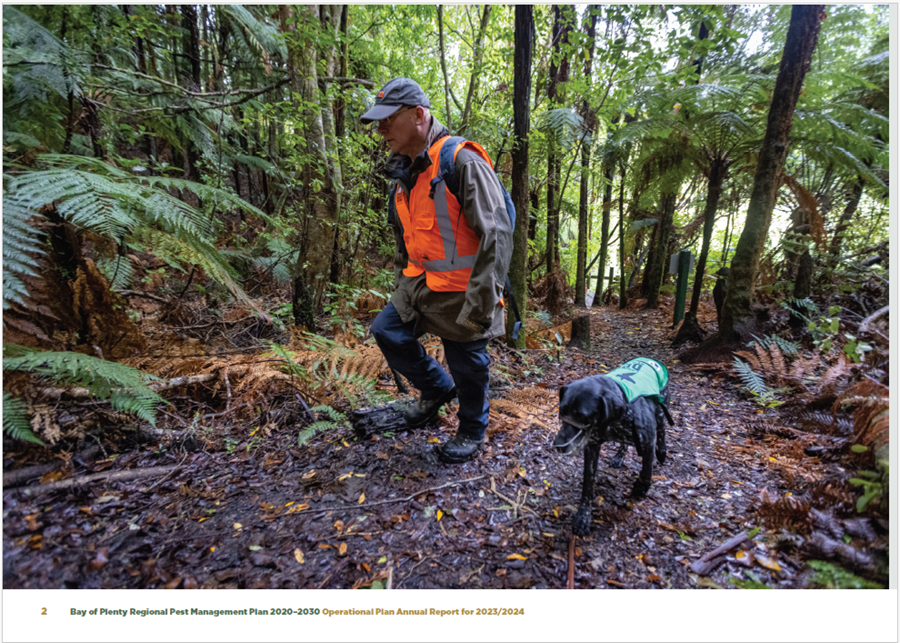
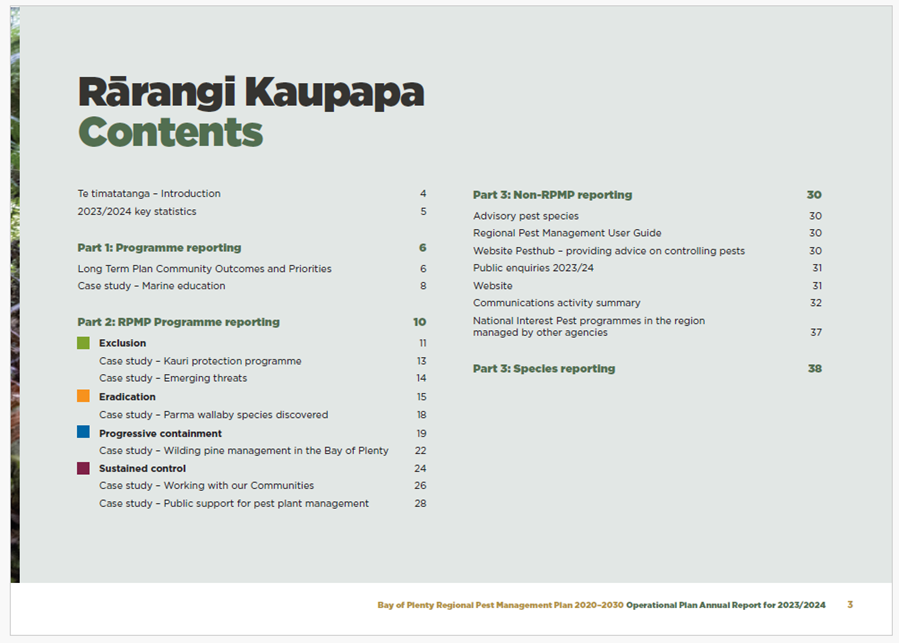



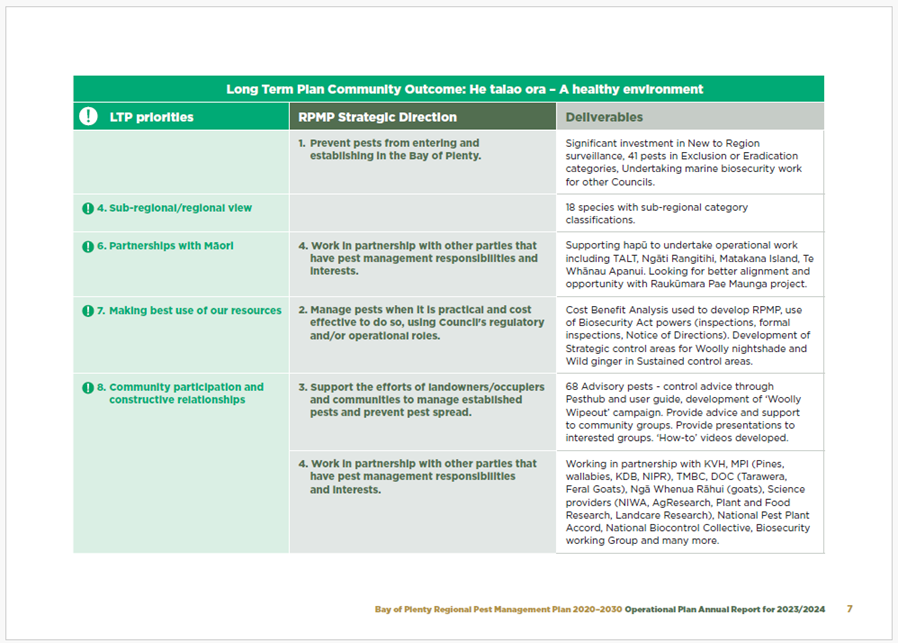
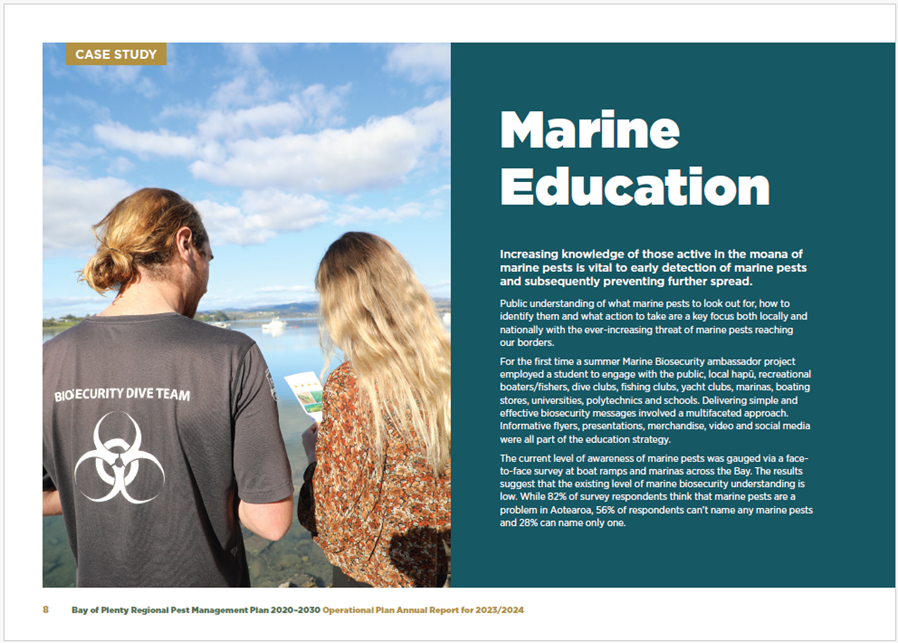
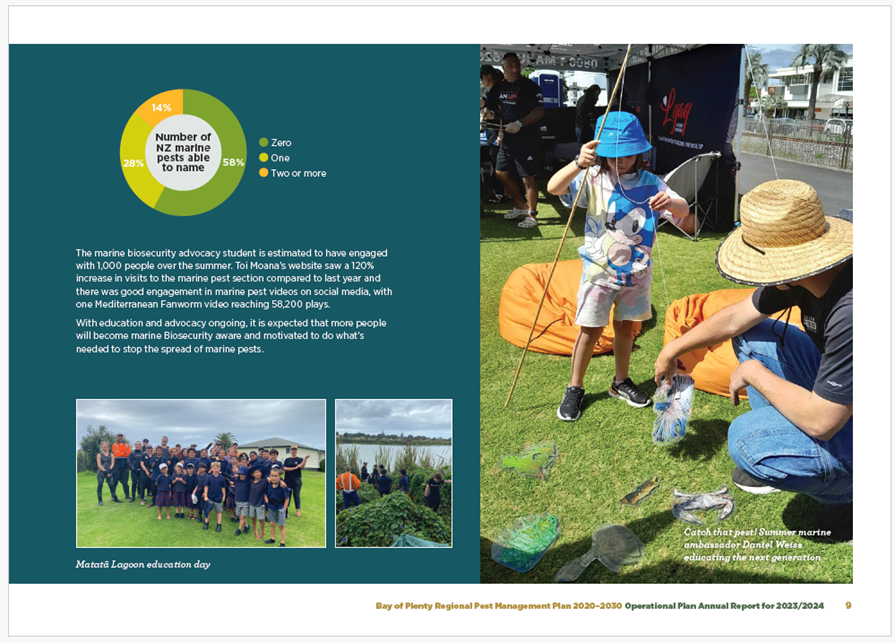




















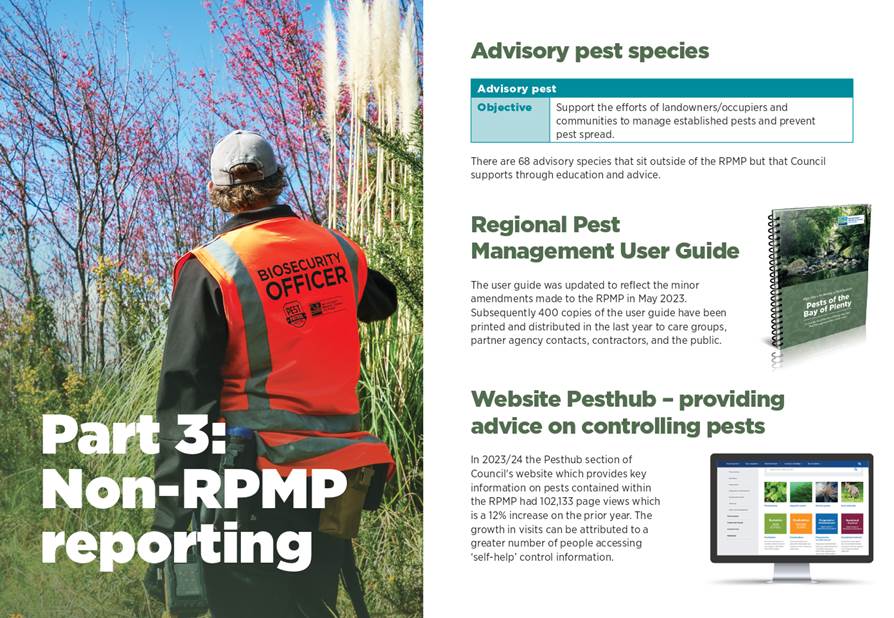








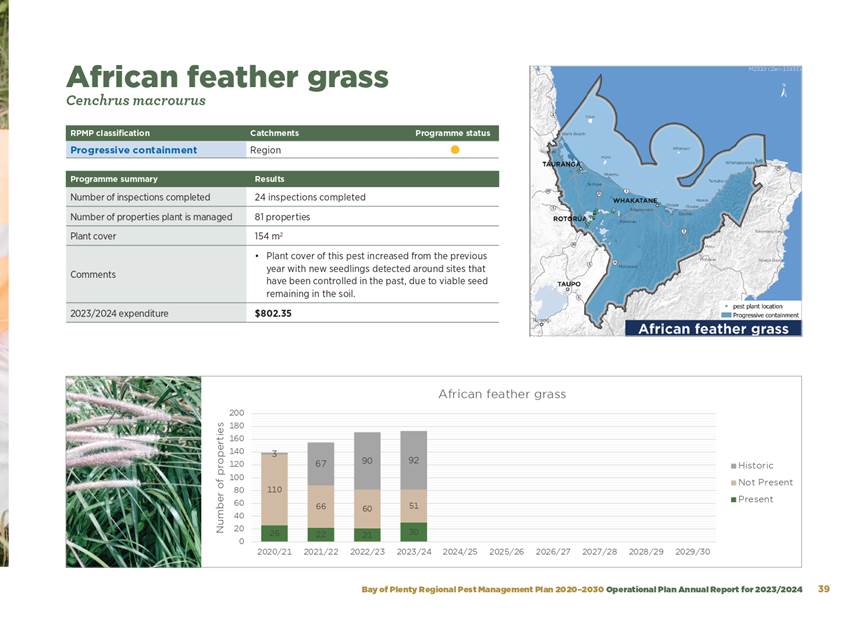
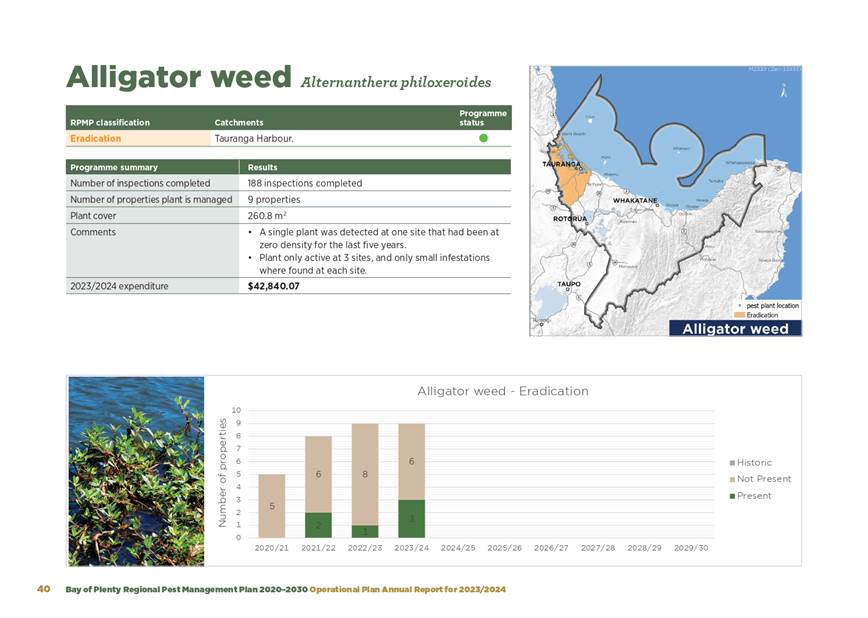
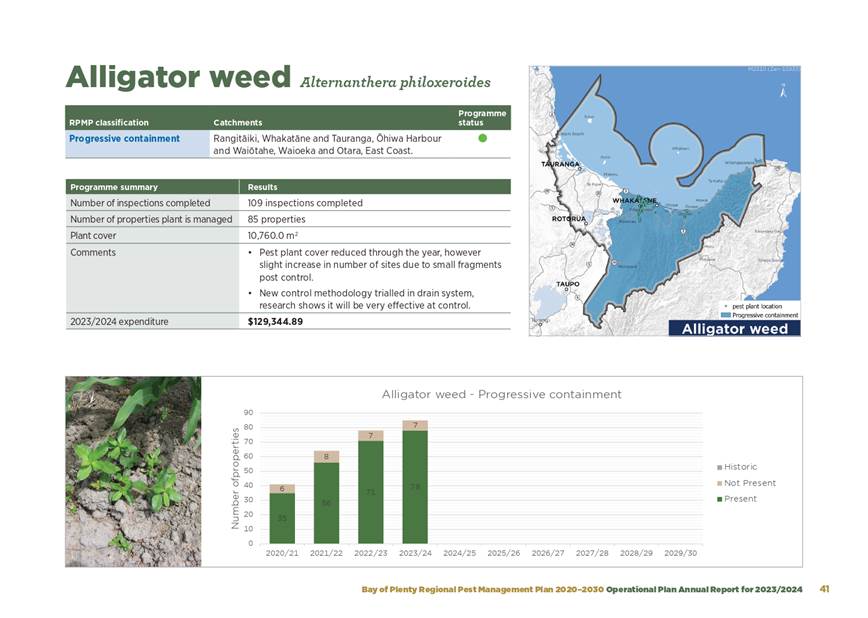

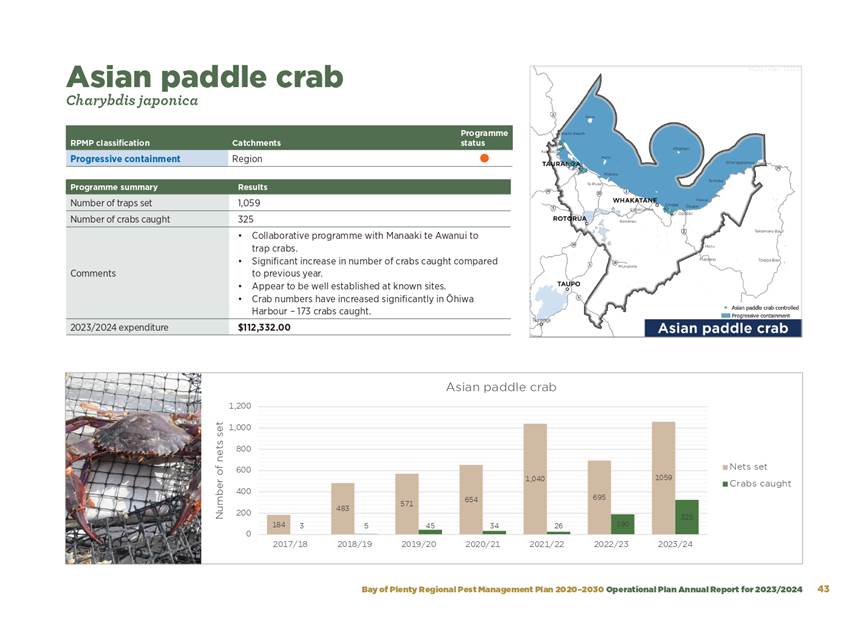
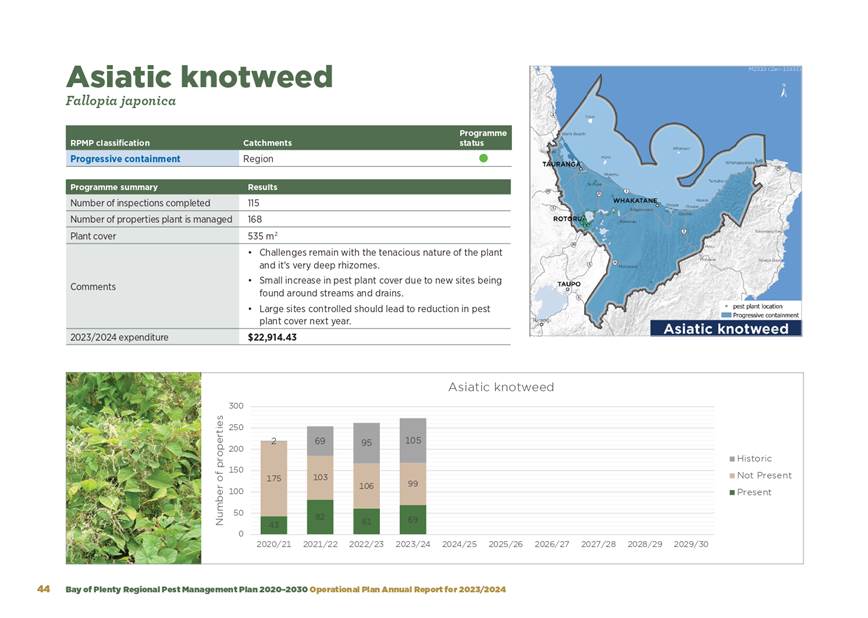
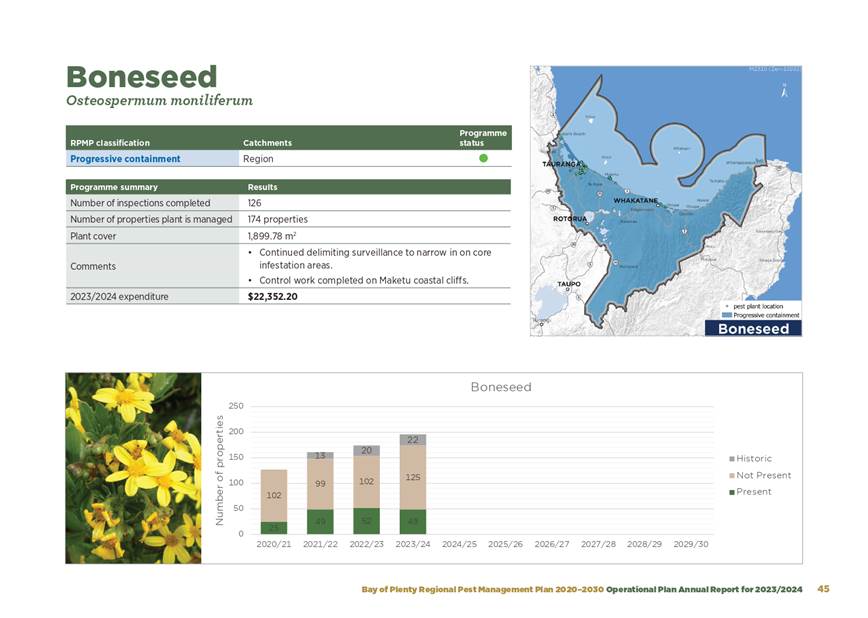

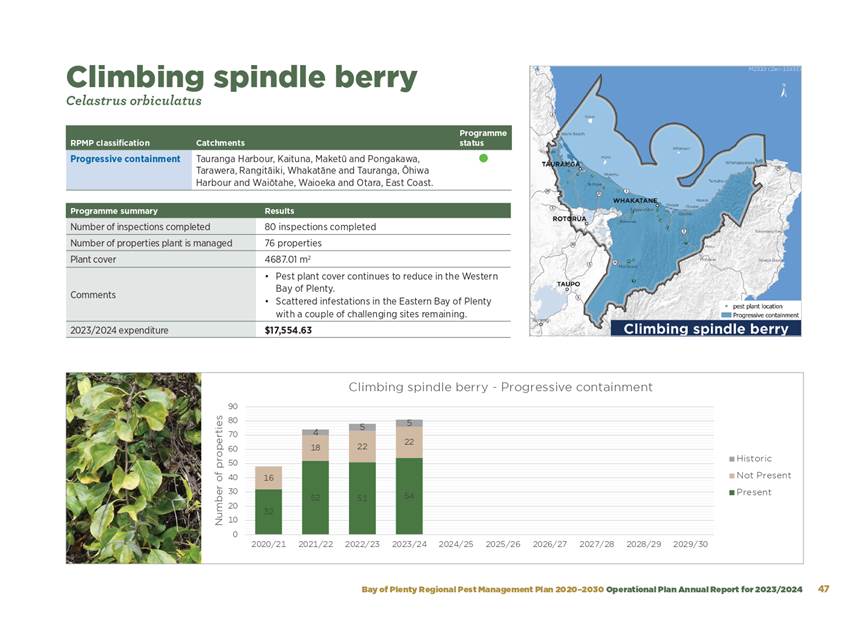
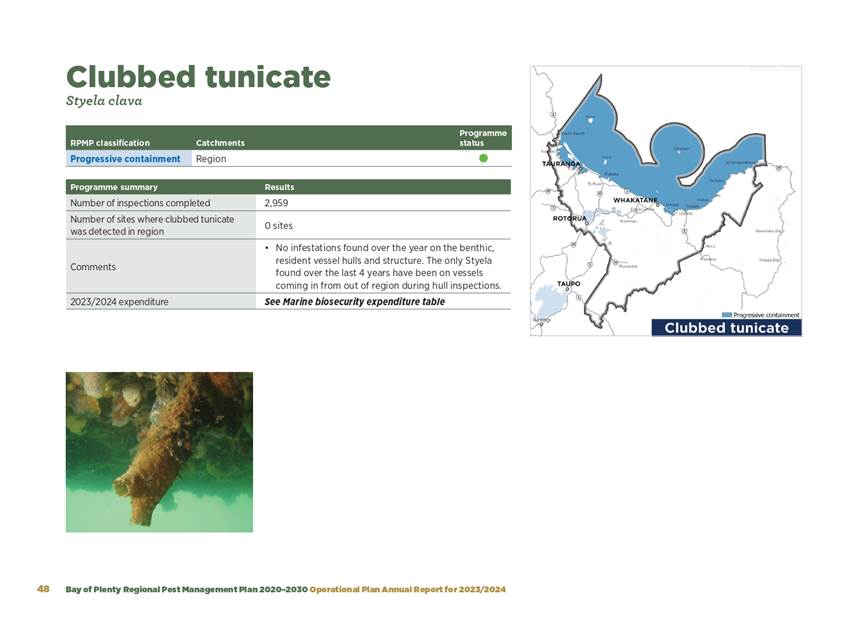
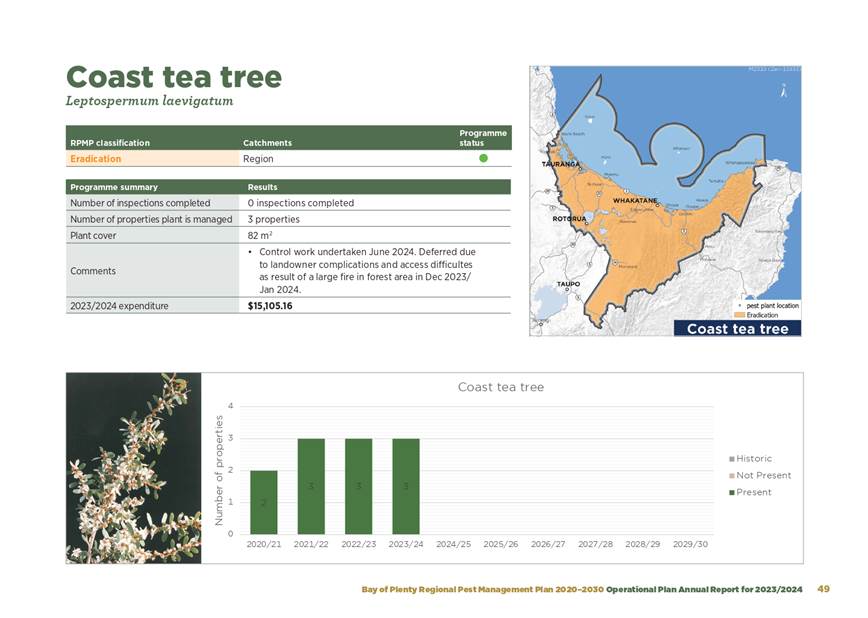
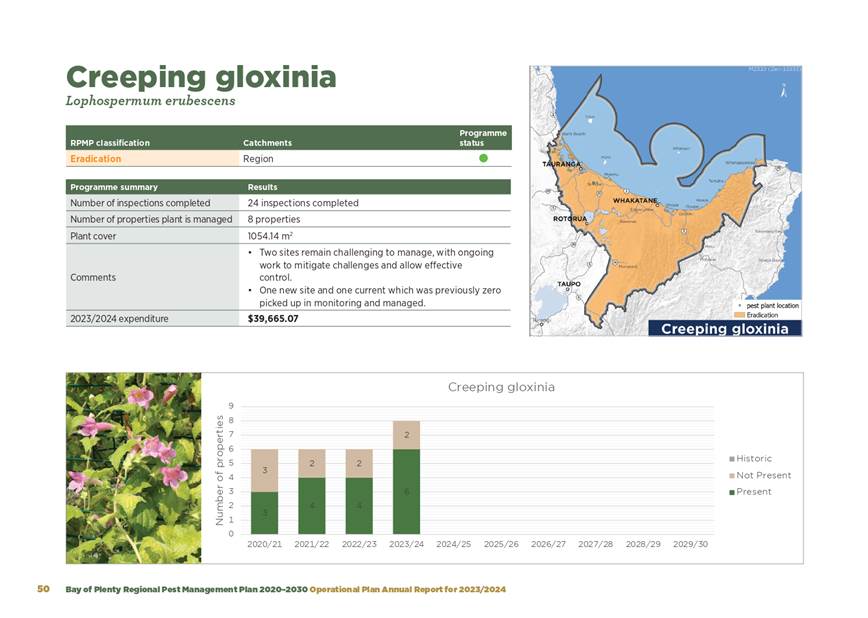
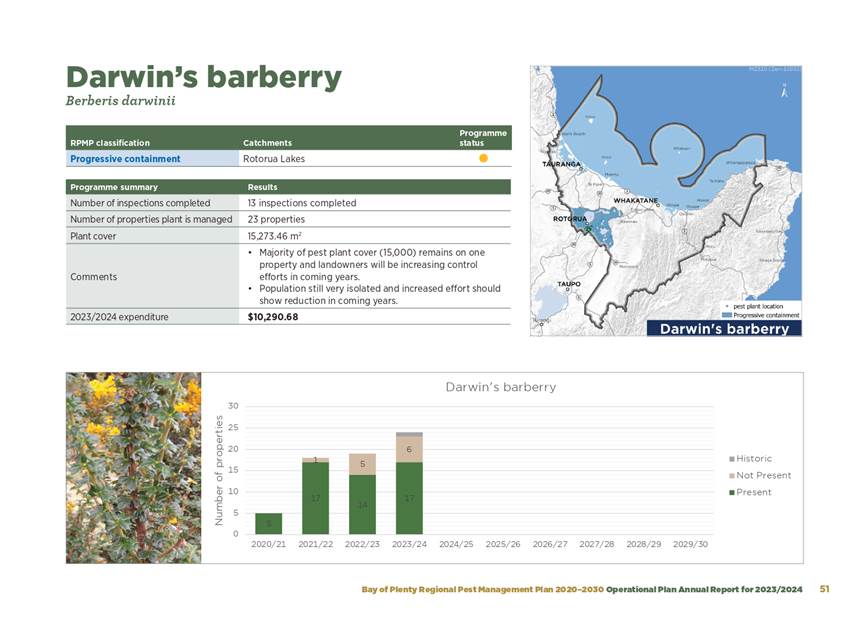
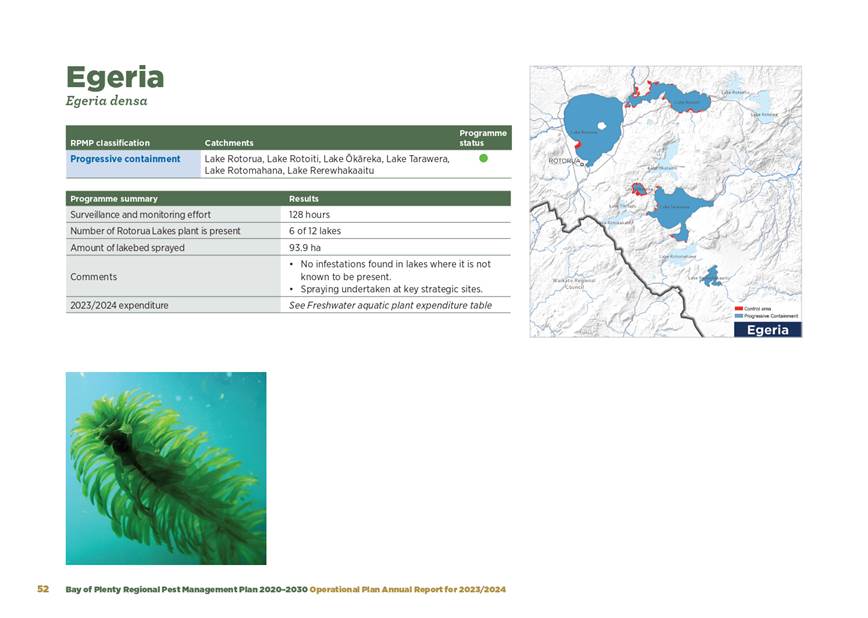
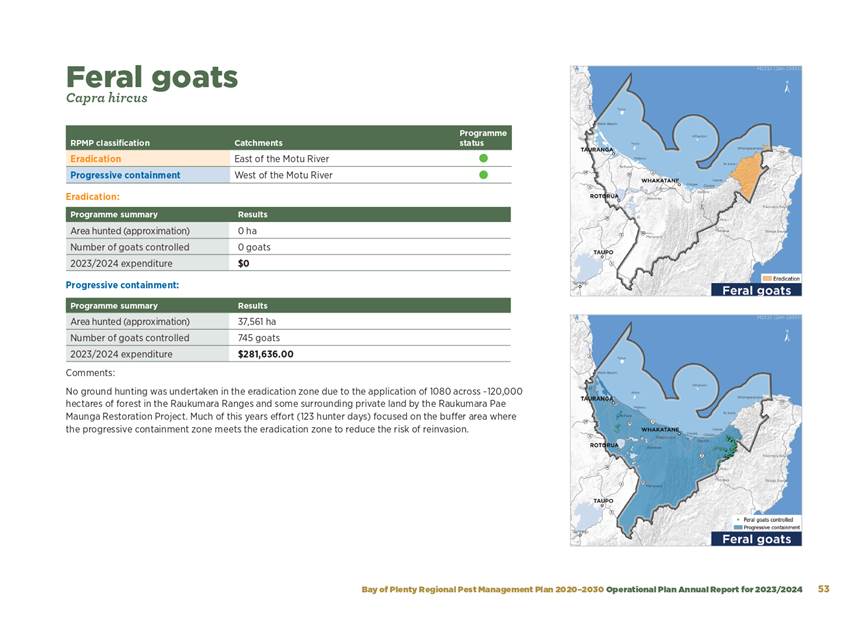
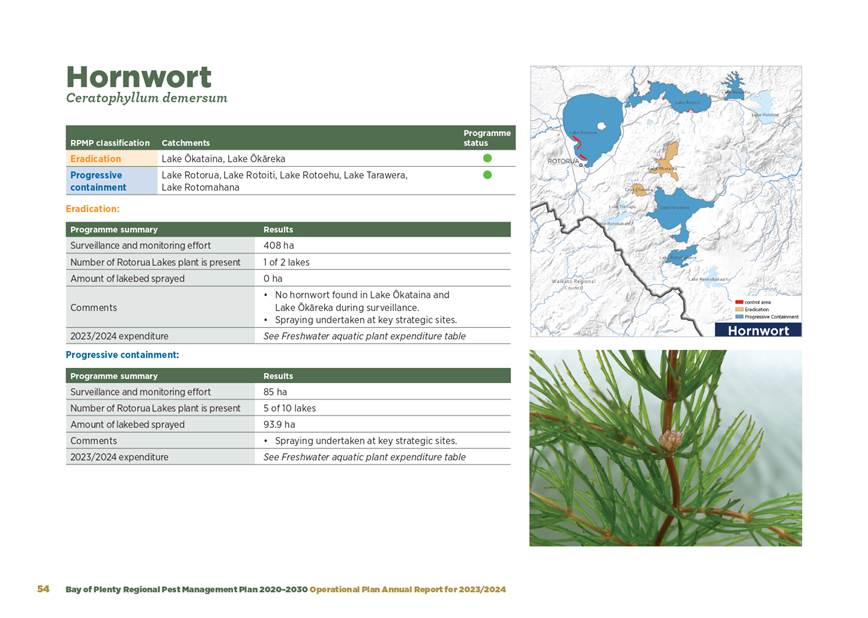
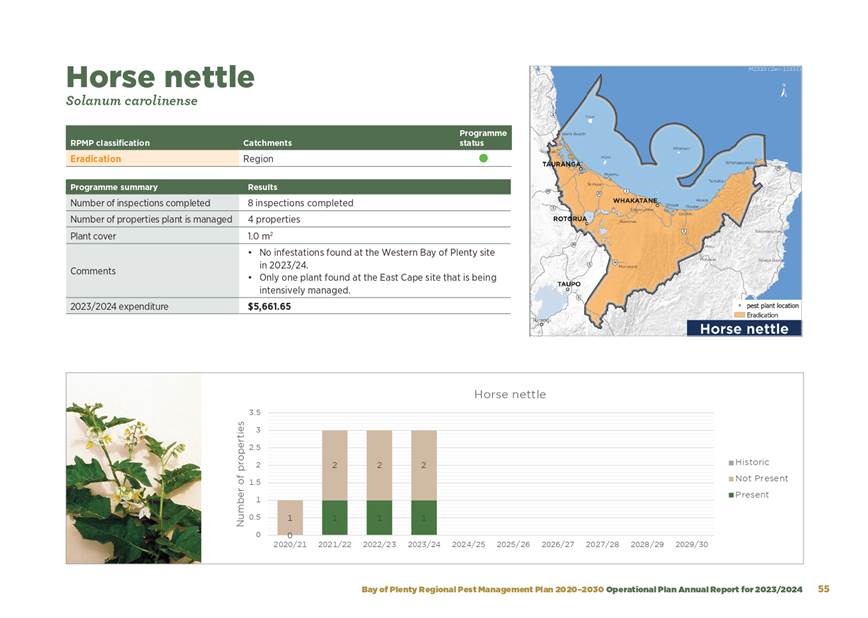
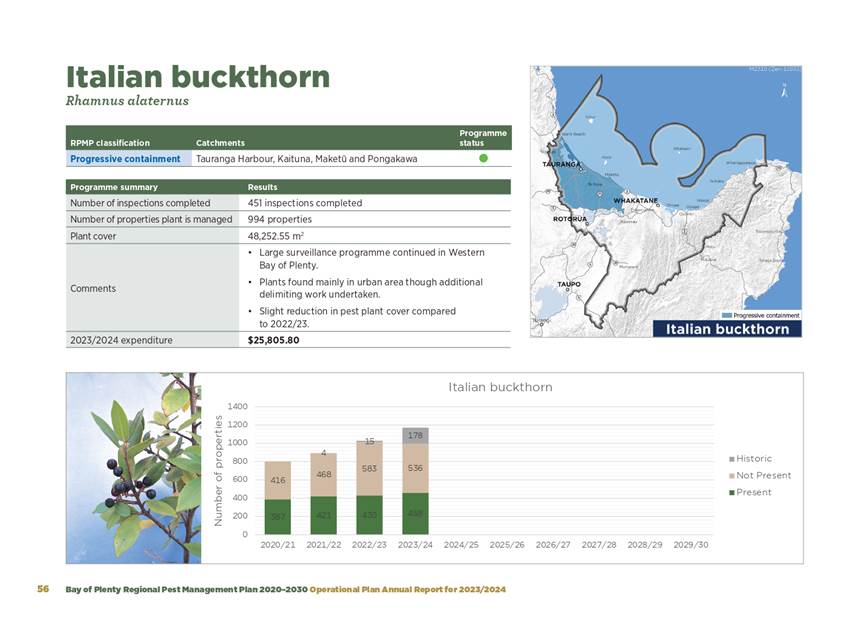
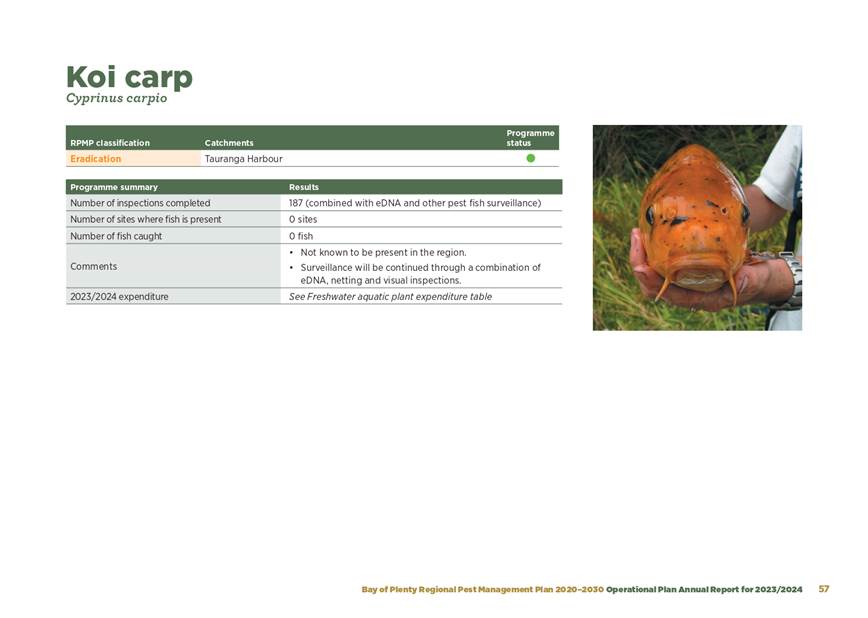
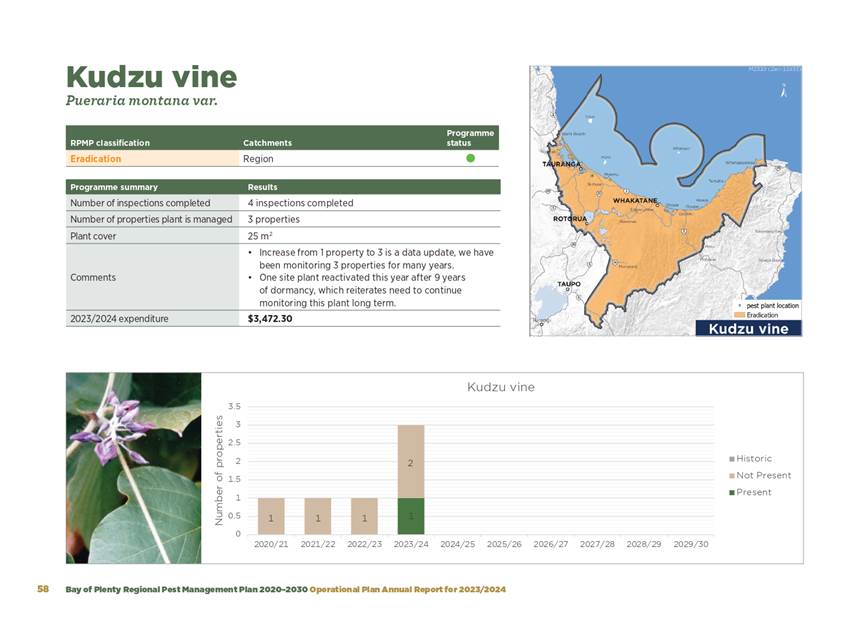
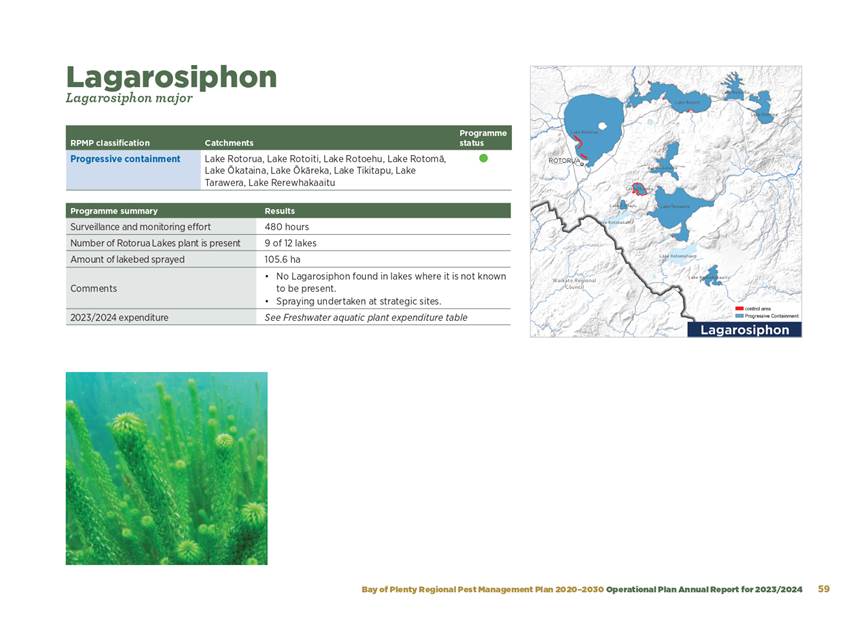
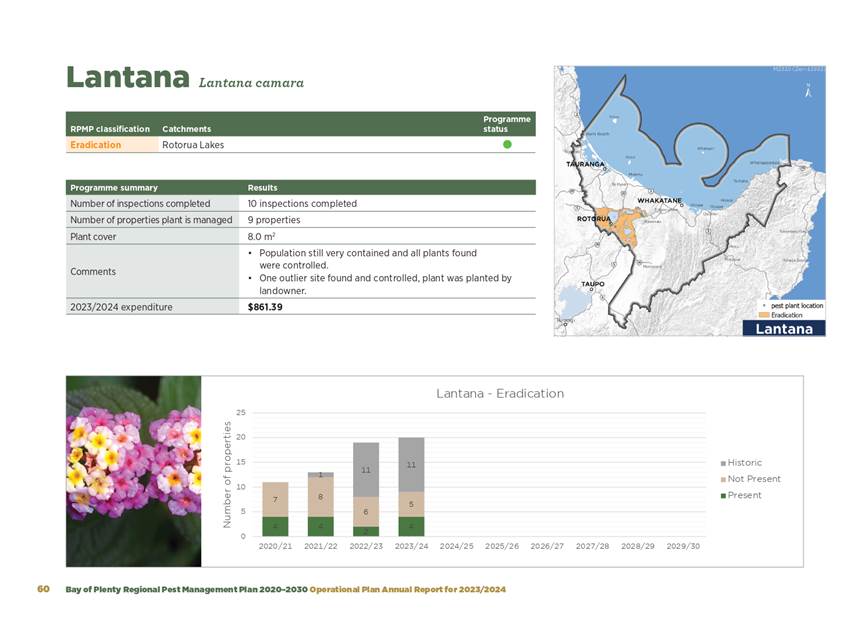
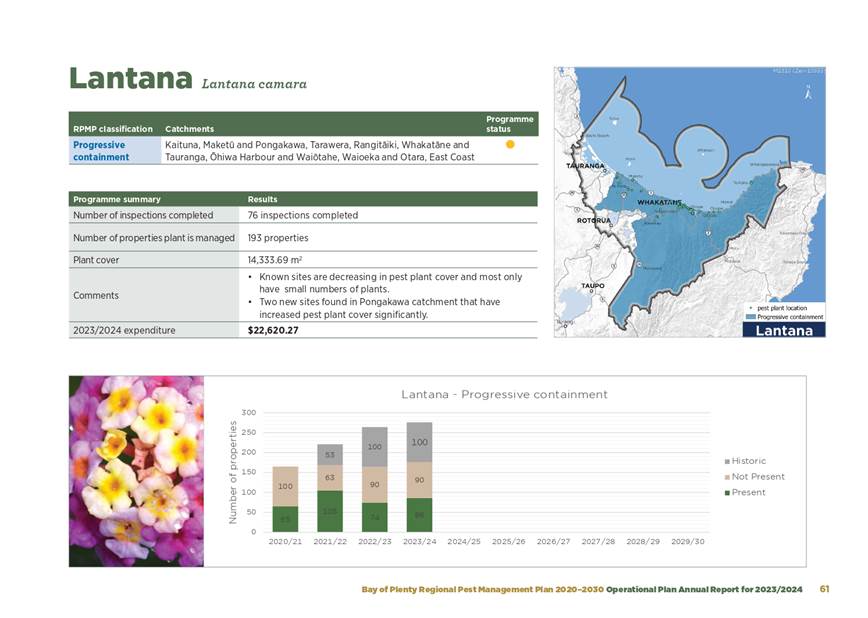
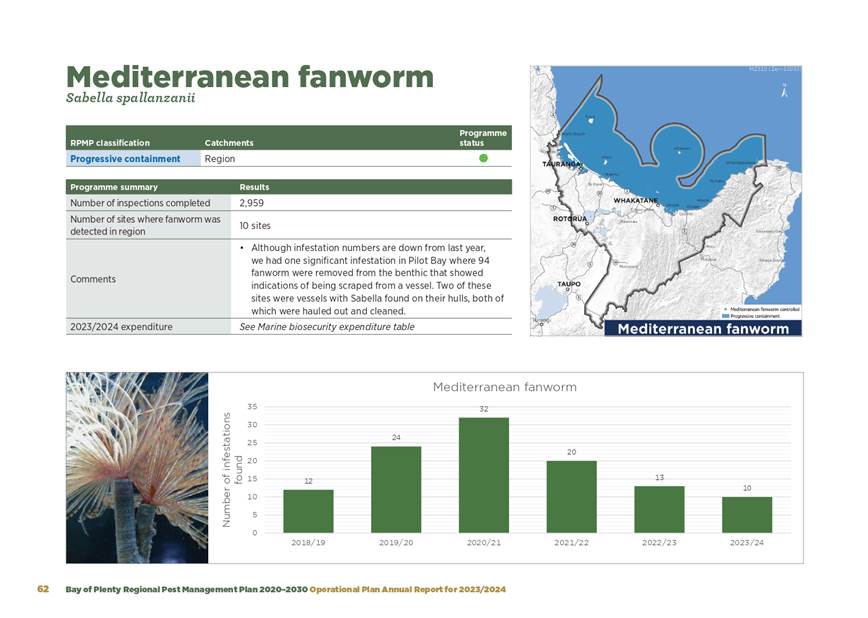
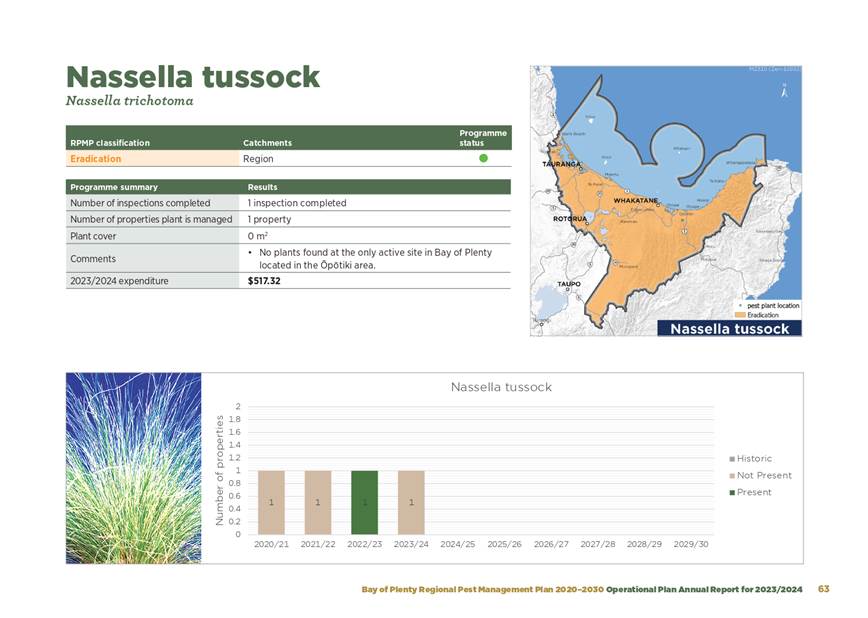
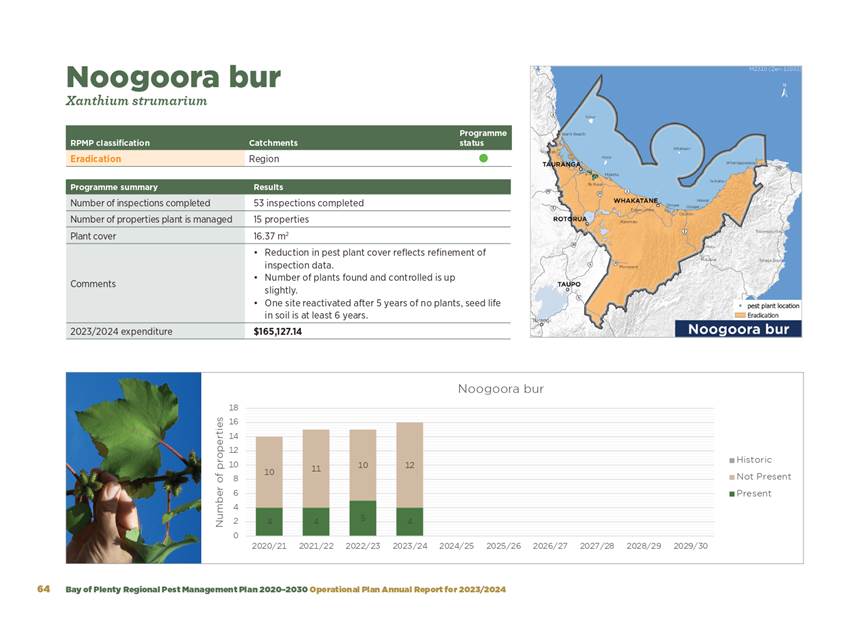
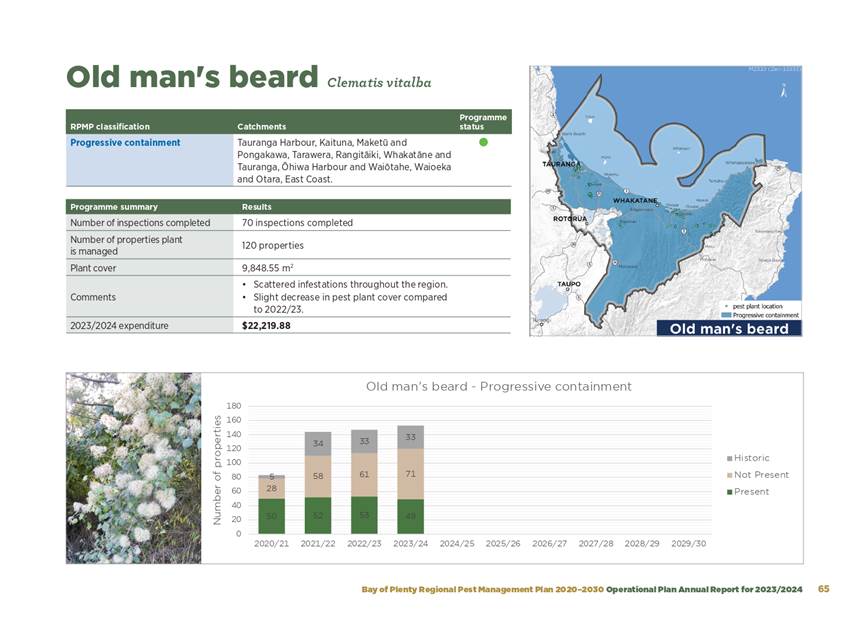
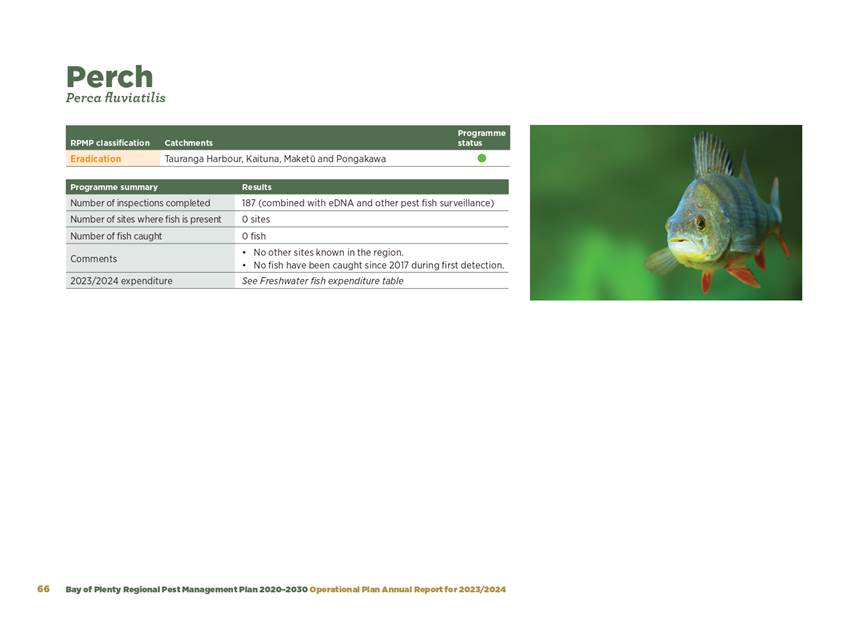
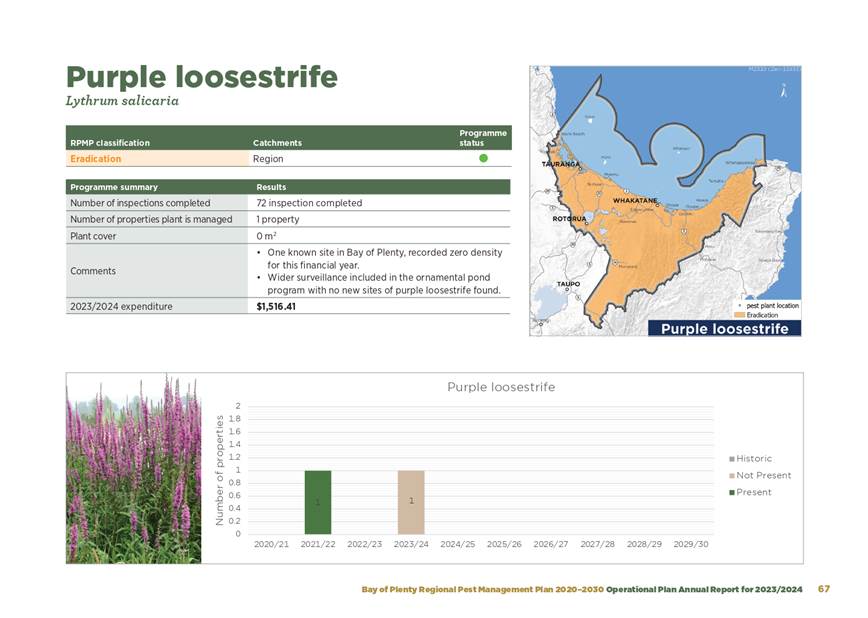
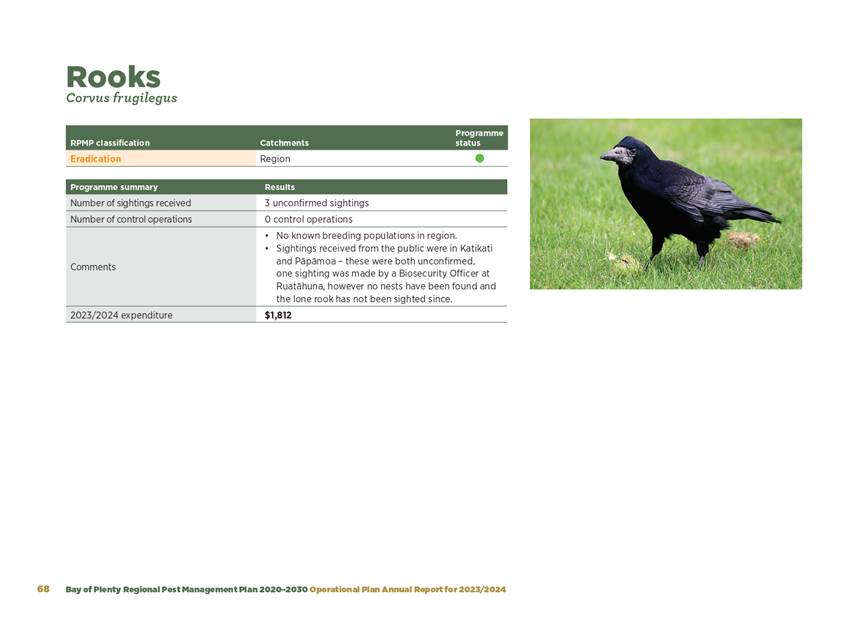
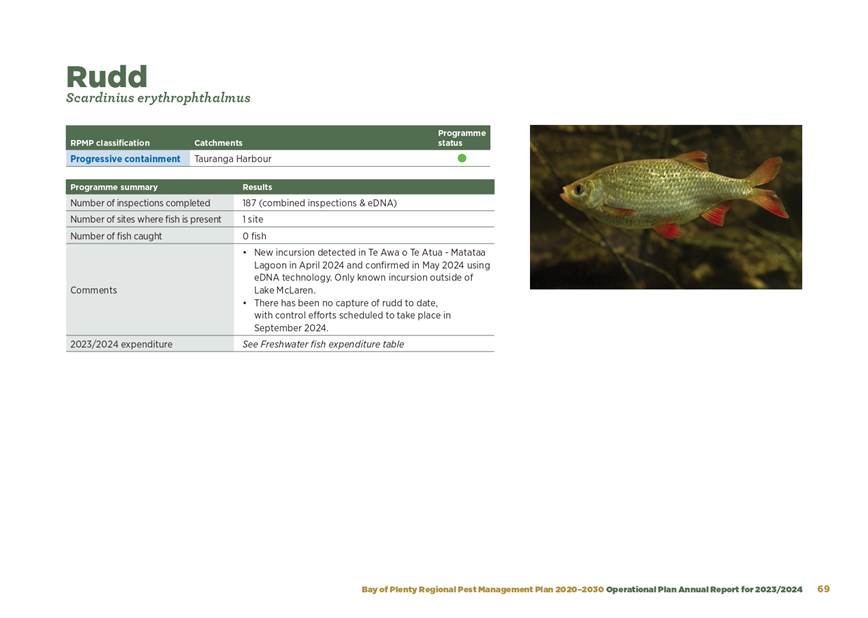
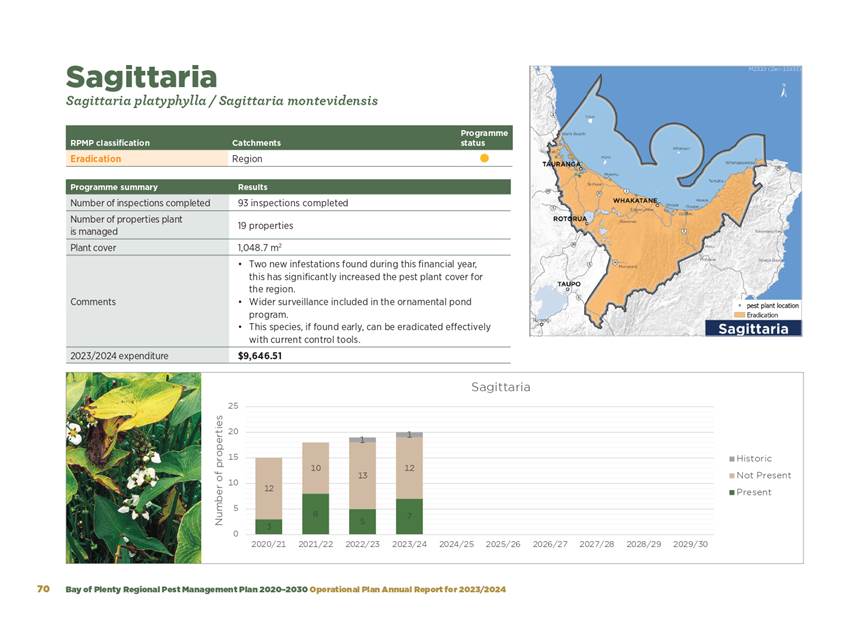
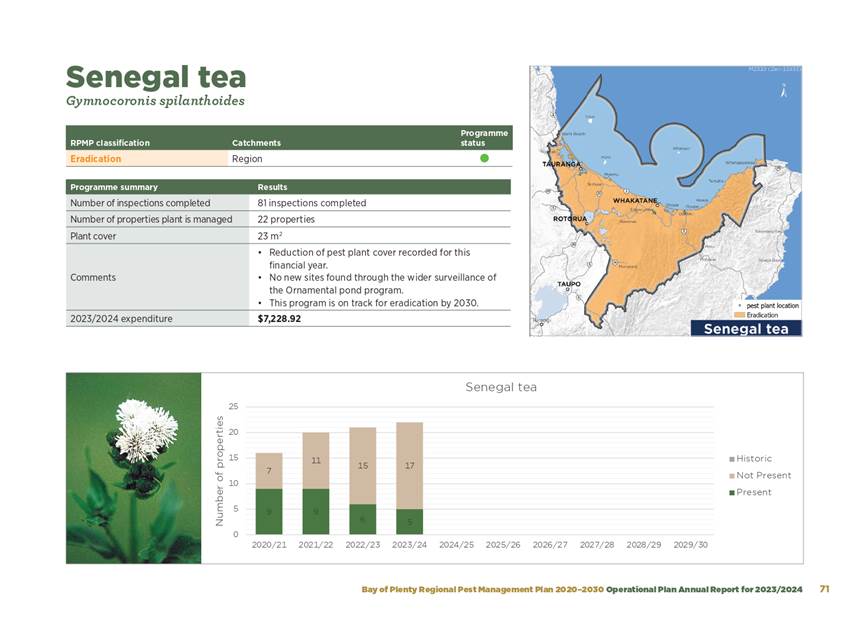
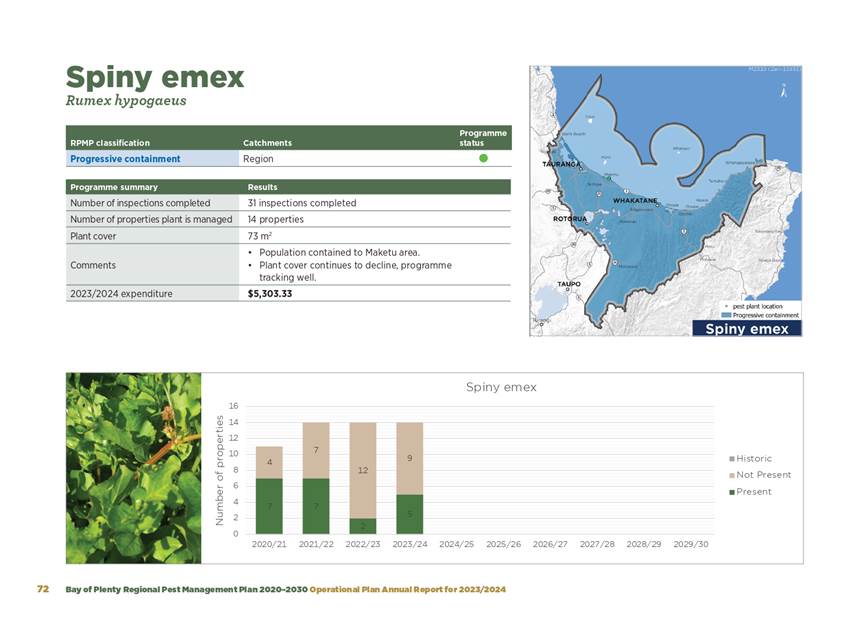
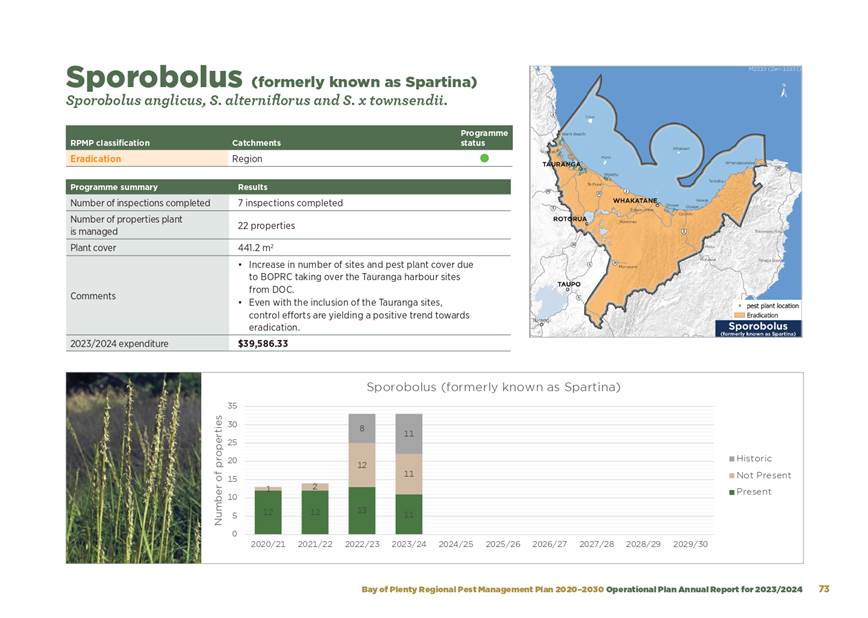
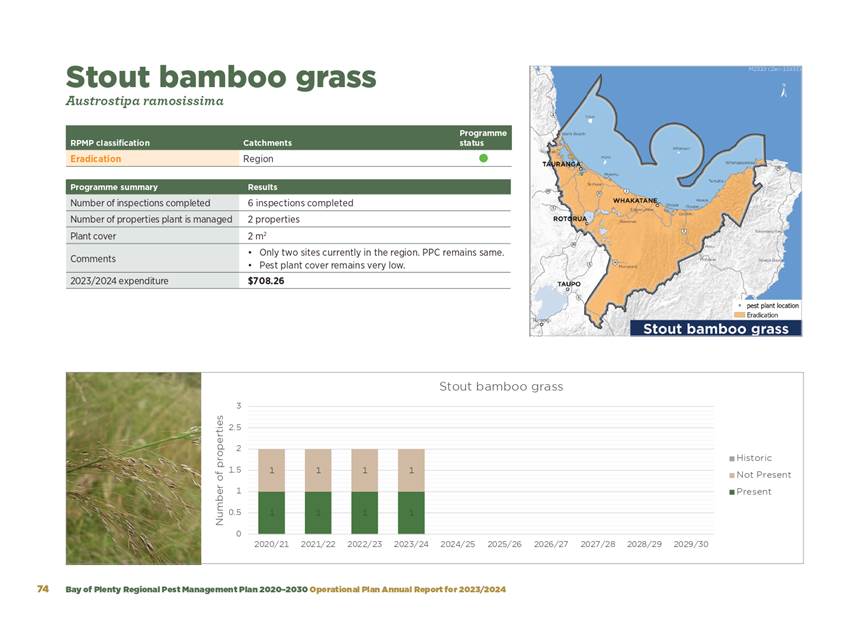
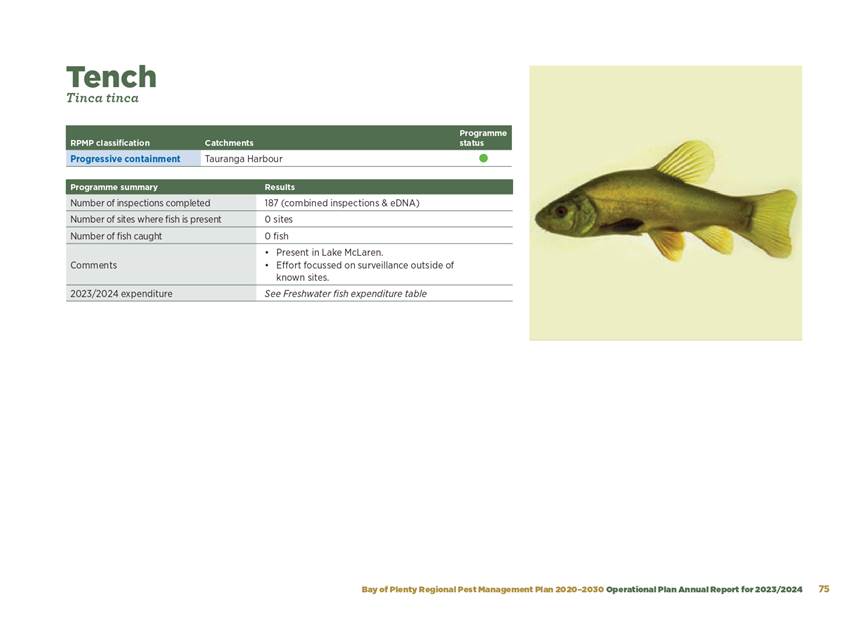
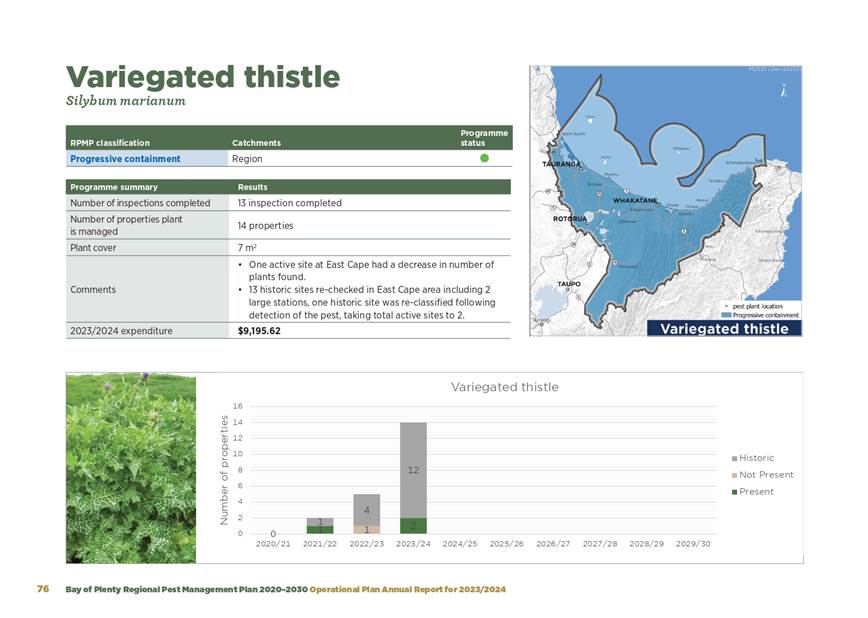
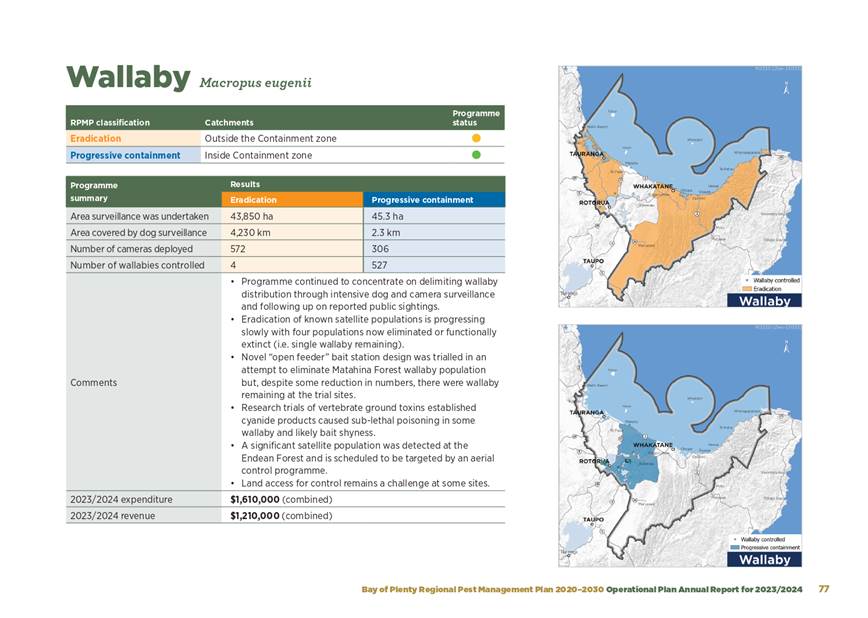
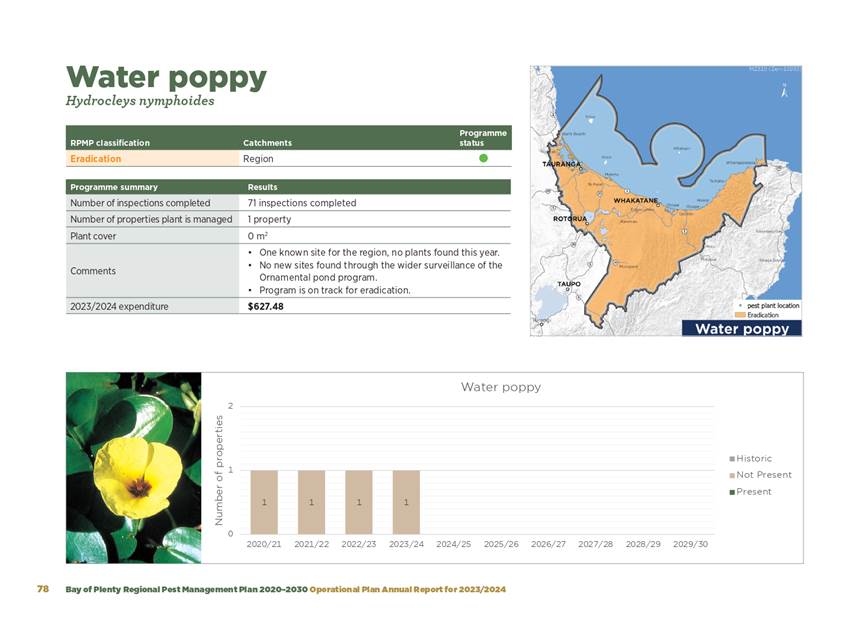
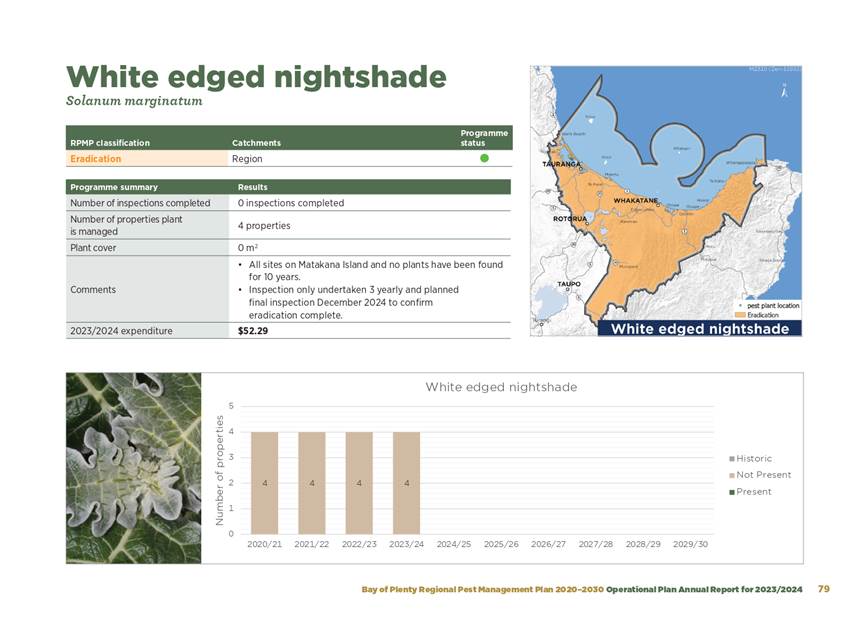
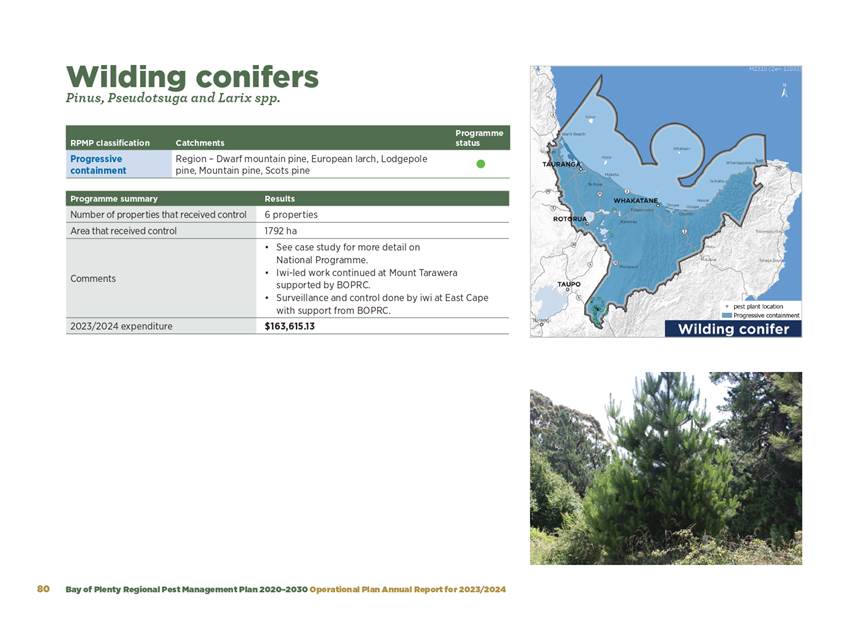
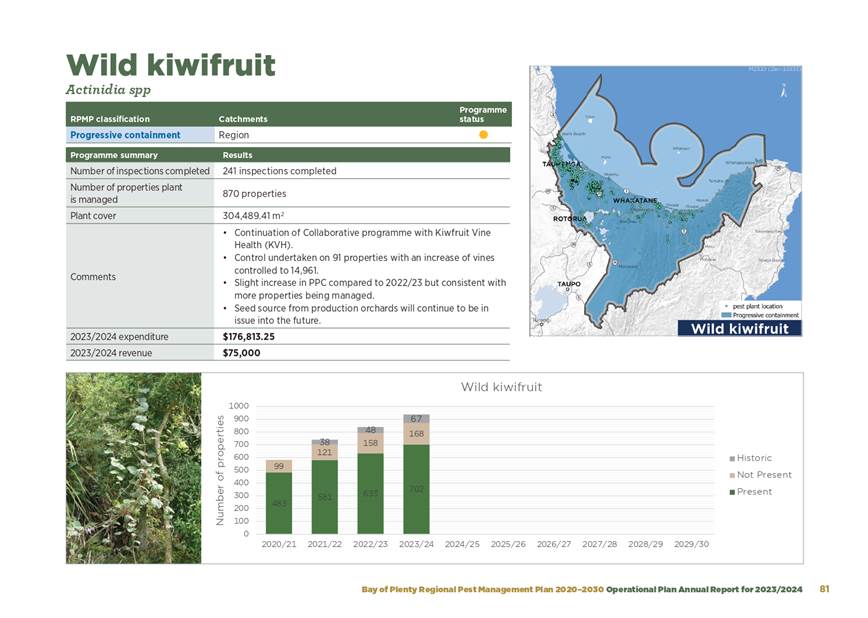
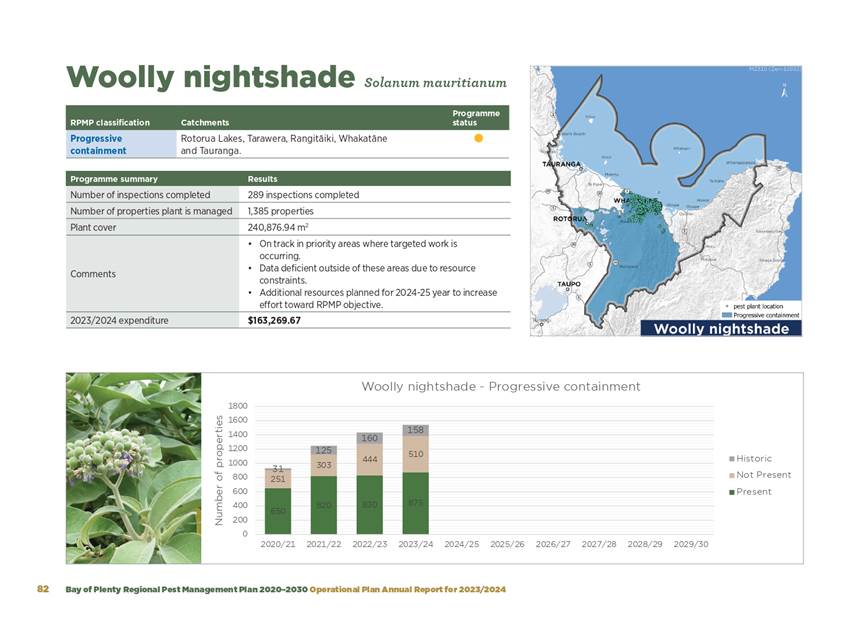
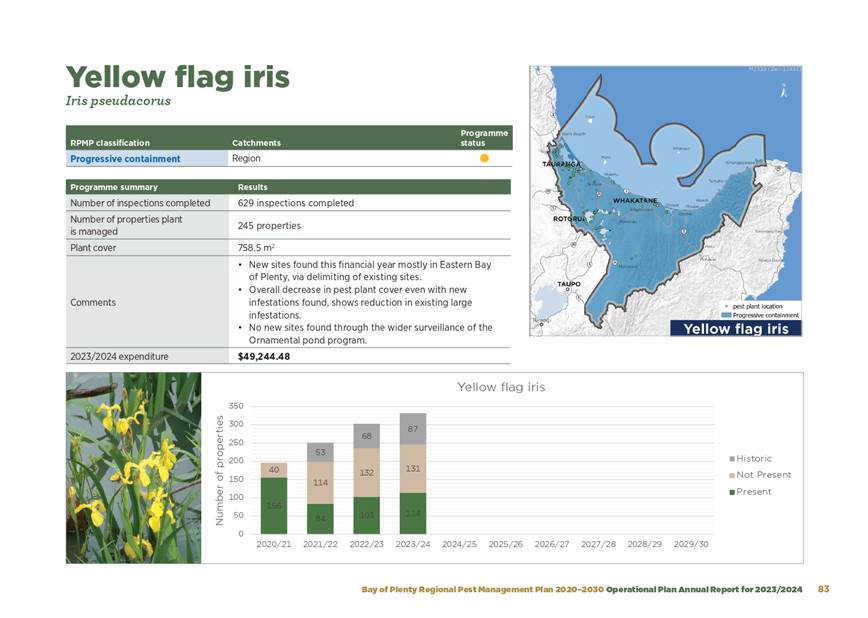


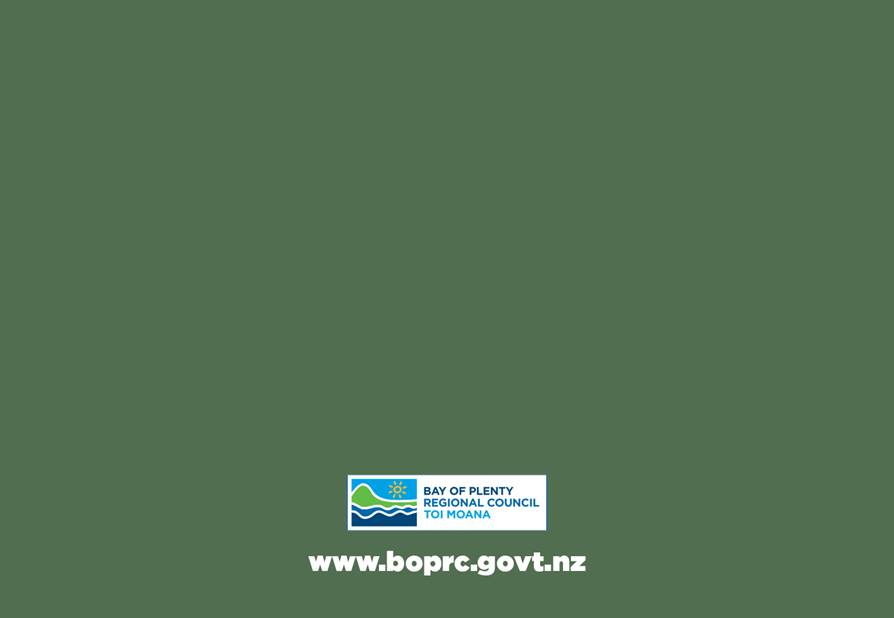
|
|

|
|
|
|
Report To:
|
Monitoring
and Operations Committee
|
|
Meeting
Date:
|
3
September 2024
|
|
Report
Writer:
|
Kirsty Brown, Rivers and Drainage
Assets Manager
|
|
Report
Authoriser:
|
Chris
Ingle, General Manager, Integrated Catchments
|
|
Purpose:
|
The purpose of this report is to
provide an update on implementing the Flood Protection and Drainage Bylaws
2020.
|
|
|
|
Implementation
of the Flood Protection and Drainage Bylaws 2020
|
Executive Summary
The current Flood Protection and Drainage Bylaws 2020 have
been operational since 1 February 2021. These Bylaws safeguard the flood
protection and drainage infrastructure assets managed by or under the control
of the Regional Council from damage and misuse.
This report provides an update on
the activities and performance in implementing the Bylaws. Additionally, it
seeks approval for the recommended proposed timeline to develop and implement
the ploughing rules under Part II of the Bylaws.
|
Recommendations
That the Monitoring and Operations Committee:
1 Receives the report, Implementation of the Flood Protection
and Drainage Bylaws 2020;
2 Approves the recommended timeline for the development of
the ploughing rules under Part II of the Bylaws.
1. Introduction
The Flood Protection and
Drainage Bylaws 2020 (Bylaws) is Regional Council’s main legislative tool
to protect and safeguard its flood protection and drainage infrastructure
assets from damage and misuse.
This report provides an update
on the recent activities and performance in implementing the Bylaws. It also
seeks feedback and approval for the recommended timeline to develop and
implement the ploughing rules under Part II of the Bylaws.
The Bylaws have
been in place since 2002. The current Bylaws have been operational since 1
February 2021.
1.1 Legislative Framework
Under the
Local Government Act 2002, regional authorities have a lead role in flood
protection activities. The Regional Council manages and maintains several river
and drainage schemes under various legislation, including the Soil Conservation
and Rivers Control Act 1941 and the Land Drainage Act 1908. The Regional
Council has the power to create and enforce Bylaws to manage and protect its
assets from damage and misuse under the Local Government Act 2002.
1.2 Alignment with Strategic
Framework
|
Future ready Communities
|
We
support community safety through flood protection and navigation safety.
|
|
The Way We Work
|
We
deliver value to our ratepayers and our customers.
|
Our work guides and supports improved resilience to natural
hazards and an equitable and sustainable transition to a low emissions future.
1.2.1 Community Well-beings Assessment
|
Dominant Well-Beings Affected
|
|
þ Environmental
Medium
- Positive
|
þ Cultural
High - Positive
|
þ Social
High -
Positive
|
þ Economic
High -
Positive
|
2. Implementation of the Flood Protection
and Drainage Bylaws 2020
2.1 Background
The Bylaws are
in place to safeguard flood protection and drainage infrastructure assets owned
or managed by the Council. These assets are essential for helping to reduce the
risk to people, property and livelihoods from river flooding and poor land
drainage.
The Bylaws are
divided into three parts:
· Part I covers all river and drainage
schemes assets managed/owned by the Regional Council.
· Part II focuses on developing and
implementing ploughing and fencing rules in the lower reaches of the
Rangitāiki, Tarawera, and Kaituna Rivers.
· Part III designates specific floodways,
spillways, and ponding areas.
Under the Bylaws,
landowners in the designated Bylaw Applicable Areas (outlined in Attachment 1)
are required to obtain a Bylaws Authority (written permission) to carry out
certain activities near scheme assets, in particular earthworks or construction
works. The Bylaws allow for co-design of specific Bylaw Management Plans where
landowners are undertaking activities, such as seasonal work or routine
maintenance, which would otherwise require multiple Bylaw Authority
applications.
The Bylaws also
highlight the importance of tangata whenua managing cultural practices and wāhi tapu sites. Co-designed management plans which integrating
Mātauranga Māori and enhance asset management and protection are
encouraged.
2.1.1 Education and Awareness
Staff have delivered several initiatives to raise
awareness and understanding of the Bylaws, making information more accessible,
engaging with affected parties, and supporting the Regional Council’s
mahi to safeguard the region’s flood protection and land drainage
assets. These include:
· On-line information query form and pre-application advice process.
· A specific webpage to provide information about the Bylaws, which
outlines why they are important, landowner responsibilities, the process for
making a Bylaw Authority application and an online application form.
· Online interactive map enabling address searches to check if a
property is within a Bylaw Applicable Area and linking back to the Bylaws
webpage for information about making an application if needed.
· Information flyers, including specific activities requiring Bylaw
Authority.
· Relationship development information sessions with key stakeholders
to raise awareness of the Bylaws e.g. real estate agents, lawyers and TLAs.
· Summer and winter Bylaws campaigns including digital communications
and letterbox mail outs.
2.1.2 Bylaw Authority Applications and
Bylaws Breach
Under
the Bylaws, there are specific Bylaw Applicable Areas where landowners are
required to obtain a Bylaw Authority to carry out certain types of works (e.g.,
construction, removal of structures, earthworks and planting) near scheme
assets.
A Bylaw Authority is written
permission from the Regional Council that includes conditions to ensure any
work carried out does not impact the integrity and performance of the asset,
rather than to restrict the landowner's use of the land.
Attachment 1 sets out the
different Bylaw Applicable Areas where Bylaw Authority is required.
The graph below provides an
overview of pre-application information advice provided, Bylaw Authorities
issued, and Bylaw breaches investigated for the period 1 July 2023 to 30 June
2024, compared to the previous four years.
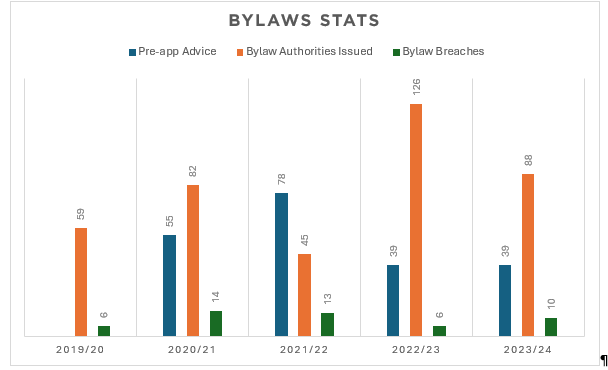
Figure 1 - Bylaw Statistics 2019/20 -2023/24
Of the 88 Bylaw Authorities
issued in 2023/24, 93% (82) were processed in line with the internal KPI target
that 75% of applications are issued within 20 working days as highlighted in
the graph below.
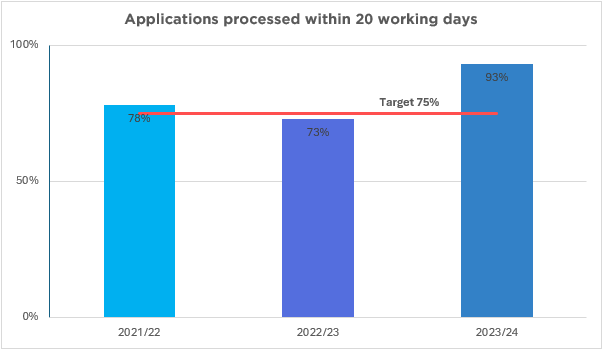
Figure 2 – Bylaw processing against KPI
During the 2023/24 period, 10
Bylaw breaches were investigated and actioned. Most of these breaches were
earthworks activities undertaken without Bylaw Authority. There were also two
incidents of over grazing of stopbanks which have been resolved.
2.1.3 Iwi/Hapū Bylaw Authority
Management Plans
As part of the
Bylaws 2020 review, an investigation was undertaken on the impact the Bylaws
could have on tangata whenua traditional cultural practices and wāhi tapu sites. As a result, new
clauses were added to the Bylaws to provide for the co-design of management
plans to protect cultural practices and wāhi tapu along with the integrity and function of Council assets.
The
Bylaws include the fundamental principle that only tangata whenua can
identify and evidentially substantiate their relationship, and that of their
culture and traditions, with their ancestral lands, water, sites, wāhi tapu and other taonga.
Summary of
progress to-date
· Based on
a prioritised risk rating, targeted engagement was undertaken with specific
hapū in 2022, inviting them to co-design Bylaw Authority
Management Plans for marae overlapped by the Bylaw Applicable Areas. While
minimal interest was shown at that time, this opportunity remains available for
the term of the Bylaws.
· During
the above process, the Kōkōhinau urupā located immediately
adjacent to the Rangitāiki River stopbank, emerged as a priority site
where staff had ongoing concerns about the potential for cultural practices to
put flood protection asset at risk.
· Staff
have worked closely with the Kōkōhinau Papakāinga Trust and the
Kōkōhinau Marae Committee to quantify the risks associated with
continued use of the urupā by engaging geotechnical analysis through 2022
and 2023. This was undertaken by Ice Geo Ltd, and peer reviewed by Beca Ltd.
· The
geotechnical analysis suggests that the upper part of the urupā can
continue to be used with low risk to stopbank security during a flood.
Additionally, two potential extension areas were identified as also posing low
risk. However, the analysis indicates that the risks associated with the
continued use of the lower part of the urupā are higher than acceptable.
To mitigate these risks, it was recommended that an overlay to protect the urupā
and the surrounding countryside be constructed.
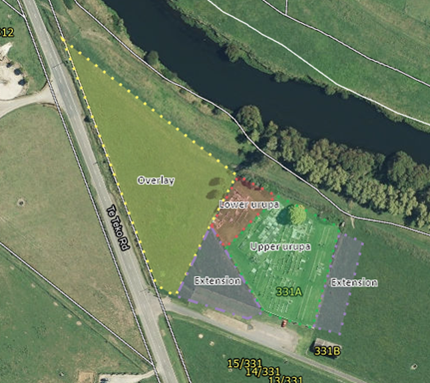
· Geotech
reports and recommendations have been shared with the Kōkōhinau
Papakāinga Trust and the Kōkōhinau Marae community. Staff
are currently awaiting further engagement with the respective parties to
progress design and construction of the overlay. Budget for this work is
confirmed in Year 2 of the LTP 2024-34.
2.1.4 Ploughing
The lower reaches of the
Kaituna, Rangitāiki, and Tarawera Rivers have layers of pumiceous soil
that are prone to seepage and piping during floods. To minimize the risk of
such failures, new clauses were added to the Bylaws during the 2019/20 review
regarding ploughing in these areas. These changes, outlined in Part II of the
Bylaws, aim to reduce the risk caused by plough pans—a compacted layer of
soil that forms after repeated ploughing.
During the 2019/20 review, it
was identified that further development and enforcement of ploughing rules
would be a multi-year program. This approach allows time to create specific
rules and rationales, work with the industry to balance risks with practical
farming practices, conduct an education program, and apply the Bylaws
accordingly. The planned approach includes:
· Researching ploughing techniques and conducting seepage modelling.
· Collaborating with stakeholders and maize-growing contractors to
establish best practice guidelines.
· Identifying high-risk sites with known seepage issues.
· Developing and managing annual maize growing through seasonal Bylaw
Authority Management Plans.
A literature review on the
effects of ploughing near rivers and its impact on flood management and
infrastructure has been undertaken, incorporating sources from New Zealand,
Australia, and other regions. Based on these findings, and advice from the
Engineering Manager, the following timeline is recommended for further
investigation and development of ploughing rules before the next Bylaws review.
|
|
Ploughing Rules Programme of work
|
|
2024/25
|
Conduct geotech investigations and
seepage modelling to improve existing information with region specific data,
as recommended by the Engineering Manager.
|
|
2025/26
|
Modelling of scenarios based on
2024/25 investigations results.
Commence engagement and collaboration
with stakeholders.
Develop options and recommendations.
|
|
2026/27
|
Use findings to inform conditions in
the revision of the Bylaws (2028-2030).
|
3. Considerations
3.1 Risks and Mitigations
Works, or damage done on or near
a flood protection or drainage asset, can impact its condition or
integrity. If the asset is weakened, there is the potential for serious
consequences in a flood event. The Bylaws play a key role in helping to minimise
this.
An inclusive Bylaws education
programme is ongoing. If communities living in Bylaw Applicable Areas are
unaware of the Bylaws or do not understand how they might be affected, there is
the potential risk of asset failure and associated impacts. To mitigate, staff
will continue to develop and undertake initiatives to communicate and educate
the importance of the Bylaws.
3.2 Climate Change
|
Mitigation
|
Adaptation
|
|
Reduce GHG emissions
|
Produce GHG emissions
|
Sequester carbon
|
Anticipate climate change impacts
|
Respond to climate change impacts
|
|
☐
|
☐
|
☐
|
☒
|
☒
|
Changes in weather patterns are resulting
in more frequent and more intense weather events, which is affecting the
magnitude and frequency of flooding. Flood protection assets are important in mitigating
the risk to our communities from the impacts of climate change and it is
crucial they function properly when needed.
The fundamental purpose of the Flood Protection and
Drainage Bylaws 2020 is to safeguard the integrity and performance of Regional
Council’s flood protection and drainage assets. The review undertaken for
the 2020 Bylaws considered climate change projections, land use changes, and
increased pressure from land development.
3.3 Implications for Māori
The current Bylaws were adopted
following a comprehensive consultation process including specific consultation
with Iwi/Hapu. Council has a responsibility to manage the risks posed by our
major rivers including the region’s major flood control and drainage
schemes. Iwi and hapū have a strong interest in the long-term management
of our rivers and waterways.
3.4 Community Engagement
|

|
INFORM
Whakamōhio
|
To provide affected communities with balanced and
objective information to assist them in understanding the problems,
alternatives and/or solutions.
|
3.5 Financial Implications
There are no
material unbudgeted financial implications and this fits within the allocated
budget.
4. Next Steps
Staff will:
· Continue to progress the Bylaws implementation programme with a
focus on co-designing Bylaw Authority Management Plans.
· Progress the recommended timeline for developing the ploughing rules
under Part II of the Bylaws.
· Continue the comprehensive educational and communication programme
for ongoing Bylaws awareness.
Attachments
Attachment 1 - Bylaw Applicable Areas ⇩
Monitoring
and Operations Committee 3 September 2024
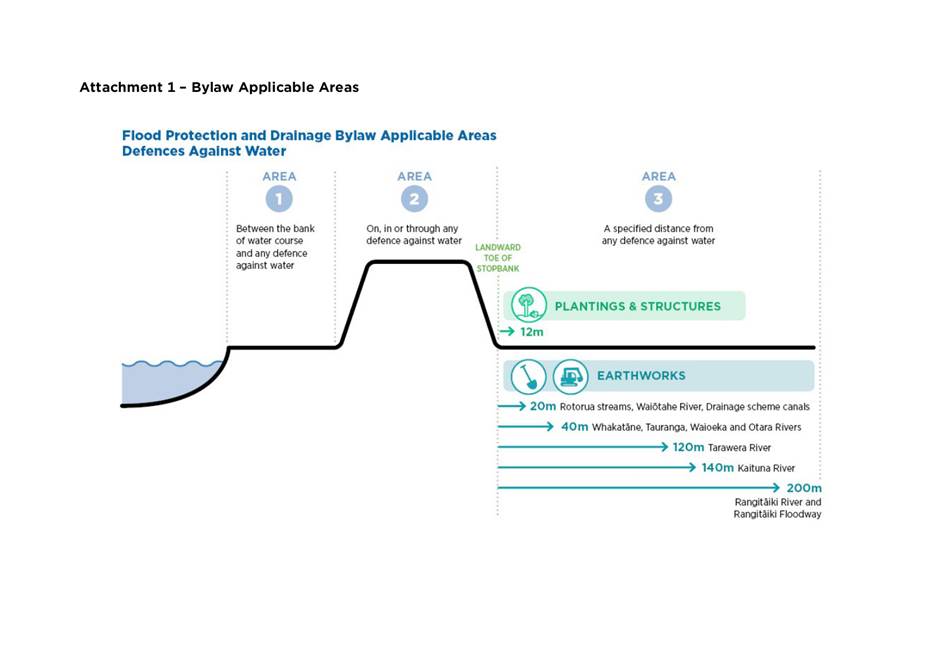
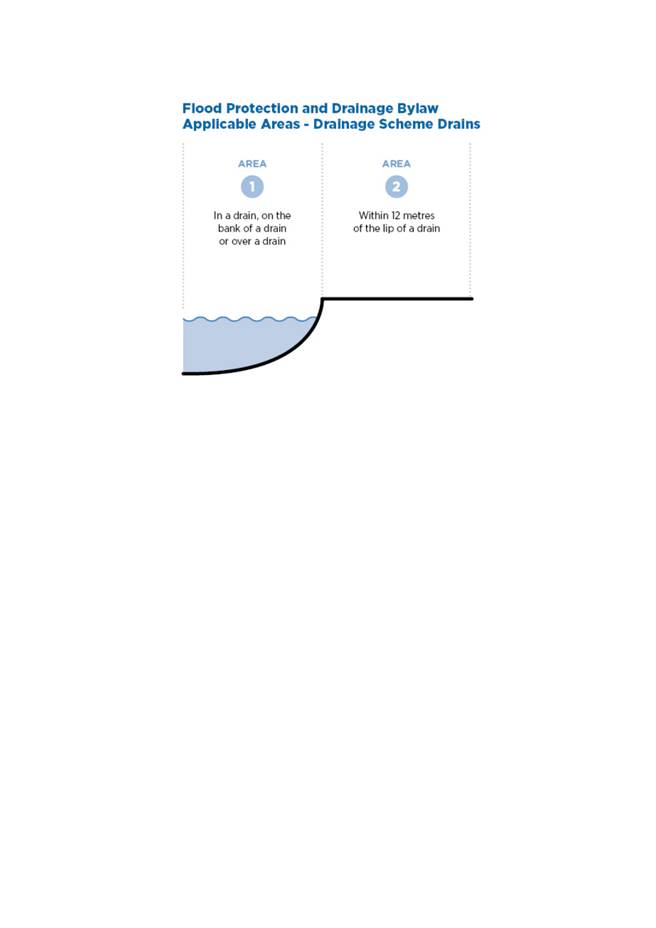
|
|

|
|
|
|
Report To:
|
Monitoring
and Operations Committee
|
|
Meeting
Date:
|
3
September 2024
|
|
Report
Writer:
|
Daniel Batten, Rivers and Drainage
Operations Manager
|
|
Report
Authoriser:
|
Chris
Ingle, General Manager, Integrated Catchments
|
|
Purpose:
|
Report on Rivers and Drainage
Operations activities, as outlined in the Environmental Code of Practice 2019
|
|
|
|
Environmental
Code of Practice for Rivers & Drainage Maintenance Activities - 2023-2024
Annual Review
|
Executive Summary
Rivers and drainage scheme
routine operational works are generally authorised by permitted activity
under the Regional Natural Resources Plan, subject to a range of conditions
including that works are carried out in accordance with the Environmental
Code of Practice for Rivers and Drainage Maintenance Activities.
One of the requirements of the
Code of Practice is to report annually to Council. This report covers rivers
and drainage maintenance activities for the 2023-2024 financial year.
Overall, 889 separate rivers
and drainage maintenance activities were carried out during the 2023/2024
financial year (see attachment 1, Table of Completed Works), and 2 complaints
were received and investigated (see attachment 2, Complaints Register).
34 Hapū and Iwi
Management Plans (see attachment 3, Hapū and Iwi Management Plans) are
currently in existence and these guide and inform operations activities and
consultation.
|
Recommendations
That the Monitoring and Operations Committee:
1 Receives the report, Environmental Code of Practice for
Rivers & Drainage Maintenance Activities - 2023-2024 Annual Review.
1. Introduction
The Environmental Code of
Practice 2019 (ECoP) covers maintenance activities undertaken by the Rivers and
Drainage Operations Section of Bay of Plenty Regional Council (BOPRC), on the
major river schemes and drainage control schemes in the Bay of Plenty region.
The purpose of the ECoP is to
set out operational procedures that will apply to all maintenance activities on
major rivers and drainage schemes, regardless of whether an activity requires a
consent or not.
Section 6.2.6 of the ECoP
requires an annual report, covering the following:
a. Number
of complaints and corrective action(s) taken,
b. Summary
of recommended changes to procedures resulting from comments made in
checklists,
c. Analysis
of types of work carried out, and any areas where complaints or problems
continue to occur,
d. Recommendation
whether and independent audit is required,
e. Listing
of authorised Iwi Management Plans.
This
review is not a formal audit. An audit is to be undertaken once in every five
year period, of at least 3% and up to 10% of any works carried out in a single
year.
This
annual review covers the period from 1 July 2023 to 30 June 2024.
1.1 Legislative Framework
· Soil
Conservation and Rivers Control Act 1941
· Land
Drainage Act 1908 and the Rangitāiki Land Drainage Act 1956
· Resource
Management Act 1991
1.2 Alignment with Strategic
Framework
|
Safe and Resilient Communities
|
We
support community safety through flood protection and navigation safety.
|

1.2.1 Community Well-beings Assessment
|
Dominant Well-Beings Affected
|
|
þ Environmental
Low -
Positive
|
þ Cultural
Medium
- Positive
|
þ Social
High -
Positive
|
þ Economic
High -
Positive
|
The Rivers and Drainage
Operations activities provide and maintain important, long-term infrastructure
which supports our community by protecting people, property and livelihoods
from flooding and land drainage issues.
2. 2023-2024 Review
2.1 Rivers and Drainage
Operations Activities
Rivers
and Drainage Operations team undertake a range of activities, as listed in Part
4 of the ECoP.
Activities include, but are not
limited to: vegetative protection works, hard engineering protection works,
river channel maintenance works, drainage management, habitat enhancement works
and flood protection maintenance works.
Major capital works (e.g. pump
station and stopbank construction projects) are not covered by the ECoP, as
they are generally covered by project specific resource consents involving
environmental best practice.
2.2 Review of procedures
2.2.1 Complaints
Minor concerns and enquiries are
not recorded, and generally can be addressed verbally. A complaint is
considered major, or formal, where some investigation and written
acknowledgement is required.
Formal complaints are recorded
in the Complaints Register. The register includes details of when the complaint
was received, complainant’s details, investigation, remedial actions and
information provided back to the complainant.
There were 2 complaints received
in the 2023/2024 financial year. One complaint was made to Worksafe, who
conducted an immediate site visit. The details of that complaint can be found
on the Complaints Register in Attachment 2. The second complaint was discussed
with the complainant, and a resolution was found for works to continue.
Some complaints were referred to
other teams within the organisation to be resolved.
All minor complaints have been
responded to directly, and where appropriate, procedures have been put in place
to prevent similar events.
2.2.2 Consultation
Landowners and occupiers are
consulted or notified (where appropriate) when works are proposed on their
property or boundaries. Consultation is undertaken by phone (or in person if
appropriate) by the Works Coordinator/Foreman responsible for the job.
Significant effort is being
applied to collaborating with Iwi/Hapū groups for works planned in their
respective rohe to improve consultation/collaboration (refer 2.4 below).
Works Notifications are sent via
email on a weekly basis, outlining the river, location, river distance, and
type of works planned for the following week. At present there are 78
recipients of the weekly notification and this number grows as collaborative
discussions take place with Iwi/Hapū teams. All works sites in the
notification are also uploaded to ArcGIS, and an embedded link in the weekly
notification email shows where the planned works are located on an aerial
photo-map.
Consultation with landowners is
an informal process and is not recorded.
2.2.3 Recommended changes
The current version of the ECoP
has been in place since 2019, and this is its fifth annual review. An annual
review is a requirement of the ECoP.
It has previously been
recommended that more efficient internal reporting on completed works commence
to assist with future reporting.
2.2.4 Analysis of works
Works continue to be recorded
using the TechOne Asset Management Module, the Fulcrum data collection
application and the BOPRC Drains app. A full migration to the TechOne Asset
Management Module is ongoing.
A summary of the types of rivers
and drainage works completed during 2023/2024 follows. A detailed list of
completed works by scheme can be found in Attachment 1.
|
|
Types of
Works
|
Total
Completed
(All Schemes)
|
|
1.
|
Vegetative protection works
|
105
|
|
2.
|
Hard engineering protection works
|
49
|
|
3.
|
River channel maintenance works
|
94
|
|
4.
|
Drainage management
|
407
|
|
5.
|
Flood protection works
|
234
|
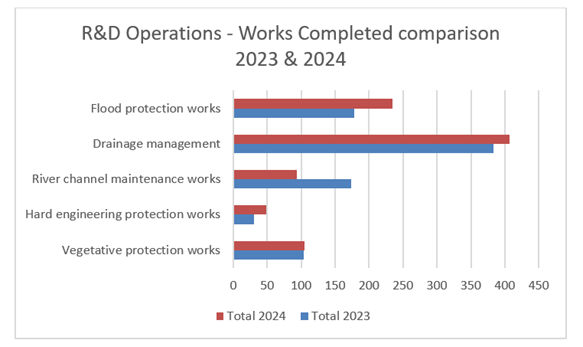
The Operations team is
proactively implementing habitat improvement works wherever this is practicable
in conjunction with planned maintenance or construction works. Often this work
involves school students growing and planting native plants at theses sties as
part of their school environmental programmes.
The Operations team is aware of
the effects management hierarchy required by the NES/NPS for freshwater and
this process is used when erosion repair works are being investigated by the
team. Softer repair methods involving vegetative, nature-based solutions are
prioritised over harder engineering options.
2.2.5 Independent Audit
And Independent Audit is
recommended at 5-yearly intervals, which is due this year.
A review of the ECoP is underway
as recommended in the April 2017 Flood Repair Project Review prepared by
Christensen Consulting Ltd, and to implement applicable requirements from the
National Works in Waterways Guideline.
2.2.6 Hapū/Iwi Resource Management
Plans (HIMP)
Hapū/Iwi Resource
Management Plans (HIMP) are documents developed and approved by hapū
and/or iwi. These plans describe resource management issues of importance to
them as tangata whenua.
The plans may also contain
information relating to specific cultural values, historical accounts,
descriptions of areas of interest (hapū/iwi boundaries/rohe) and
consultation/engagement protocols for resource consents and/or plan changes.
A list of HIMPs are included in
attachment 3.
3. Considerations
3.1 Climate Change
While matters addressed in this
report are of a procedural nature, river scheme asset planning and operational
activities are focused on adapting to climate change impacts, particularly
applying ‘room for the river’ thinking, for ongoing community
resilience and safety. Favouring nature-based solutions is more positive from a
carbon emissions perspective, as are planting projects associated with habitat
improvement projects.
3.2 Implications for Māori
Council acknowledges that the
relationships it has with Māori are central to the fulfilment of its
statutory responsibilities and will continue to utilise a range of different
mechanisms to engage with the wider Māori community and ensure Māori
views are appropriately represented in the decision making process.
At an operational level, efforts
to engage with Māori are ongoing through various forums including the
established co-governance groups (e.g. Rangitāiki River Forum and Te Maru
o Kaituna).
At an operational level, staff
are working hard to work more collaboratively with Iwi/Hapū to discuss and
agree on work programmes and working with Iwi/Hapū contractors if
resources and skills are appropriate. Collaborative hui have been held with
Hapū river committees including Ngāti Ira, Ngāti Tamahaua,
Ngāti Awa, Ngāti Manawa, Ngāti Rangitihi, Te Uru Taumatua and
Tapuika.
3.3 Community Engagement
|

|
INFORM
Whakamōhio
|
To provide affected communities with balanced and
objective information to assist them in understanding the problems,
alternatives and/or solutions.
|
3.4 Financial Implications
There are no
material unbudgeted financial implications and this fits within the allocated
budget.
4. Next Steps
Continue to deliver planned works and services in
keeping with the Rivers and Drainage Asset Management Plan and Environmental
Code of Practice 2019.
Attachments
Attachment 1 - Table of completed R&D Operations works 2024 ⇩
Attachment 2 - Complaints Register ⇩
Attachment 3 - Hapu/Iwi Resource Management Plans ⇩
Monitoring
and Operations Committee 3 September 2024
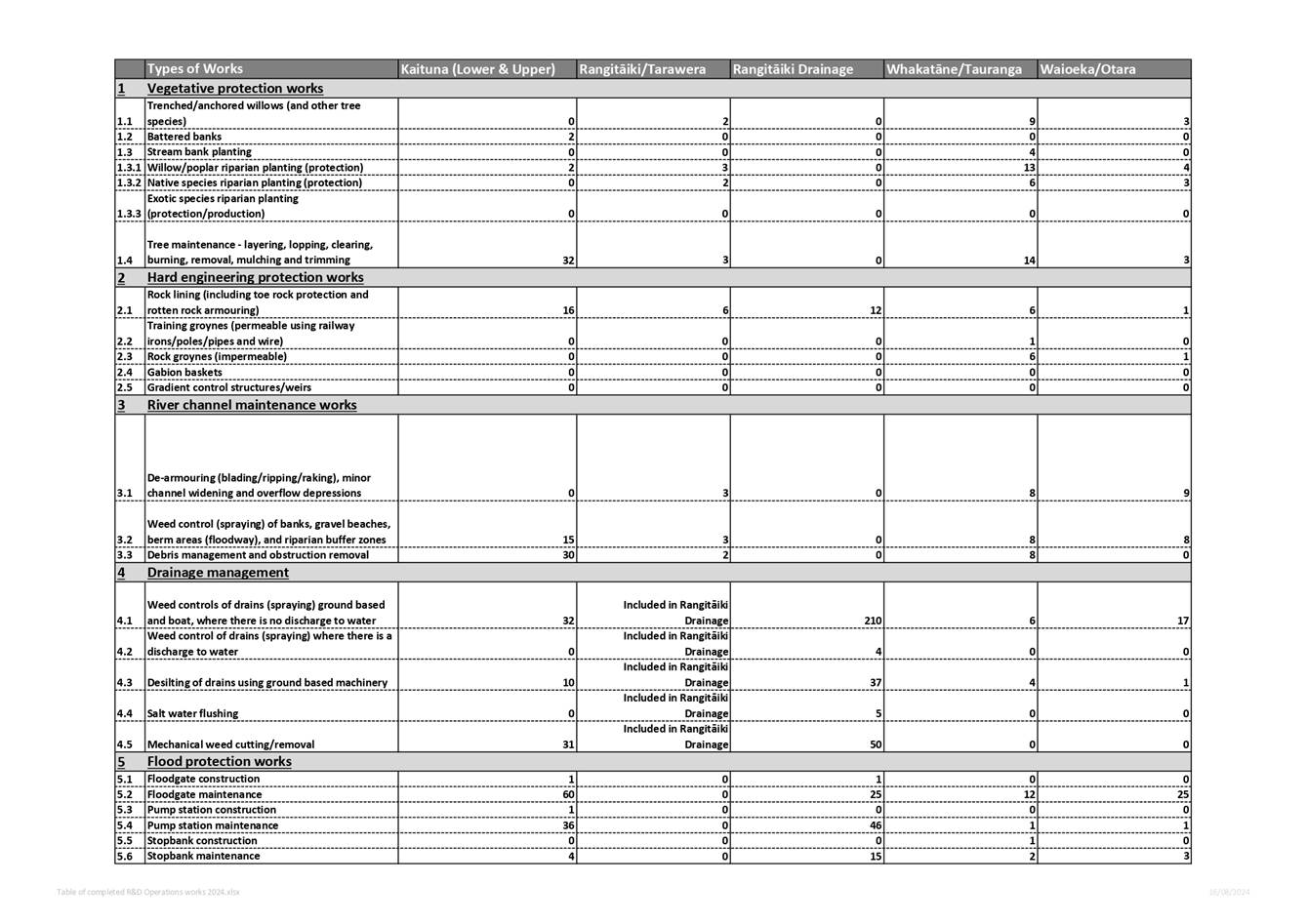
Monitoring
and Operations Committee 3 September 2024
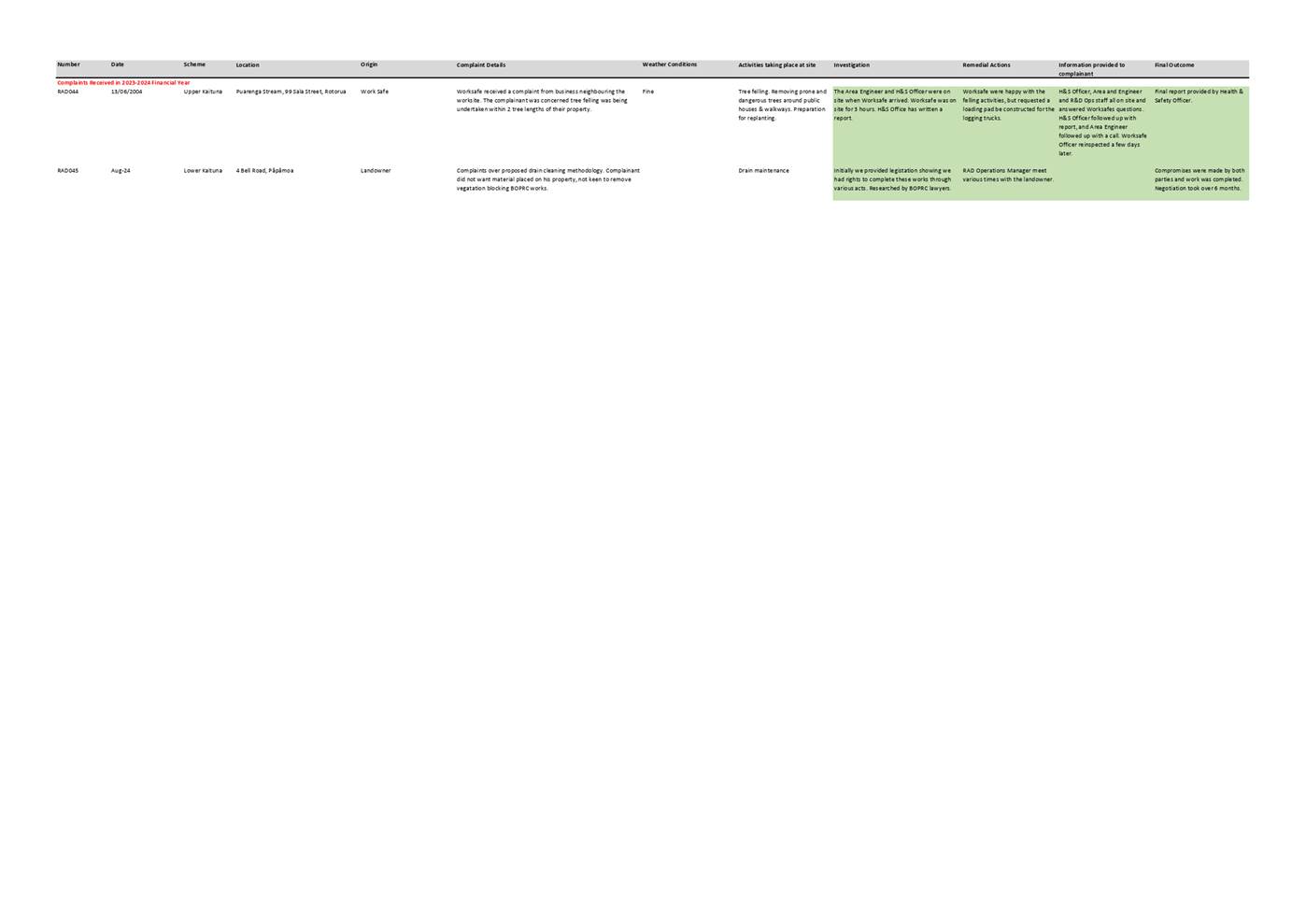
Monitoring
and Operations Committee 3 September 2024
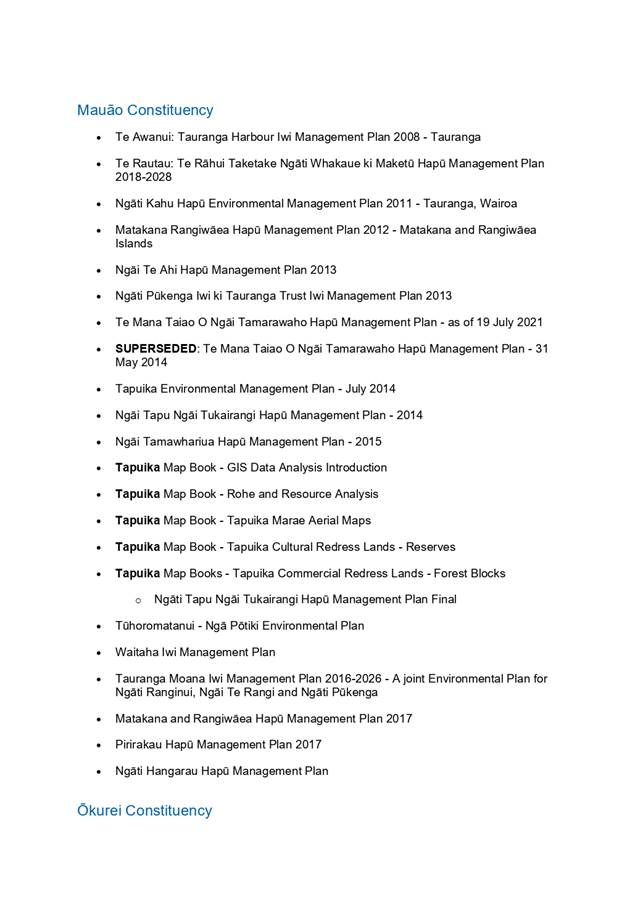
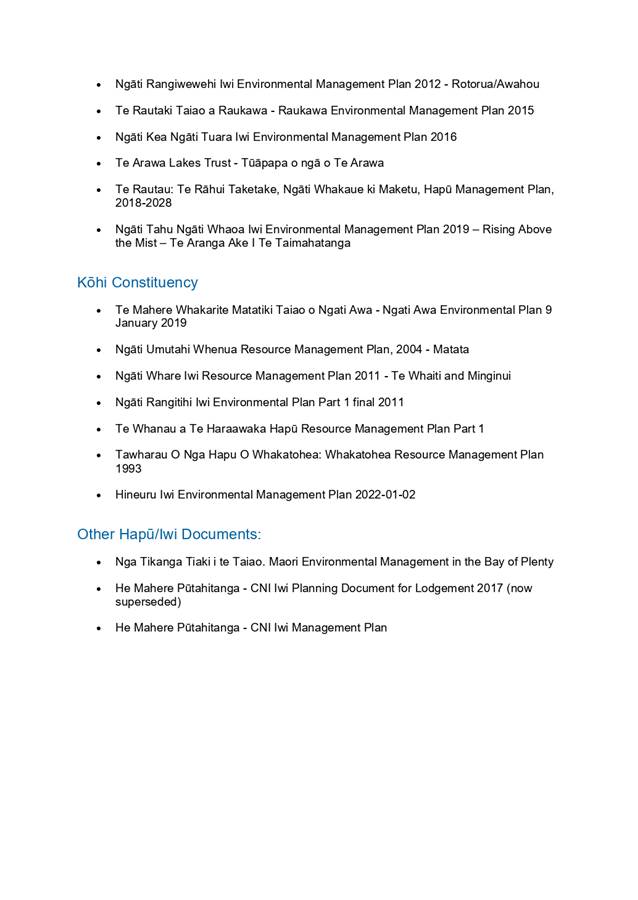
|
|

|
|
|
|
Report To:
|
Monitoring
and Operations Committee
|
|
Meeting
Date:
|
3
September 2024
|
|
Report
Writer:
|
Sharlene Pardy, Team Leader Policy
(Environmental)
|
|
Report Authoriser:
|
Namouta
Poutasi, General Manager, Strategy and Science
|
|
Purpose:
|
To advise the Monitoring and
Operations Committee of the district resource consent applications received,
commented on, or submitted on, by the BOPRC, for the year 1 July 2023 to 30
June 2024.
|
|
|
|
District
Consent Applications Annual Report 2023/24
|
Executive Summary
Regional council makes comments on district
consent applications to help achieve integrated management of the natural and
physical resources in the region, to ensure the Regional Policy Statement and
various national policy statements are implemented as intended, and to
achieve administration efficiencies when regional consents are also required.
This report provides an overview of the resource
consent applications received by the region’s territorial authorities
and commented or submitted on by Bay of Plenty Regional Council from 1 July
2023 to 30 June 2024.
Regional council staff considered 398 resource
consent applications referred from the region's territorial authorities
during 2023/24 under agreed protocols with each council.
The comments made by regional council are
generally reflected in the decisions, and as conditions of consent or advice
notes of those consents granted.
Comments were provided on 393 of those
applications (98%). The number of applications referred to Bay of Plenty
Regional Council represented 26% of the total applications received by the
territorial authorities.
We are making improvements to this process
following an efficiency review and are working with local Councils to recover
costs for contaminated land advice.
|
Recommendations
That the Monitoring and Operations Committee:
1 Receives the report, District Consent Applications Annual
Report 2023/24.
1. Introduction
Bay of Plenty
Regional Council (BOPRC) has protocols with each district and city
council in the region and the Minister of Local Government for the four outer
islands for receiving and evaluating resource consent applications made to
those territorial authorities (TAs). There are three main reasons for doing
this: (i) to help achieve integrated management of the natural and physical
resources in the region in accordance with s30 of the Resource Management Act
1991 (RMA); (ii) to ensure the Regional Policy Statement and various national
policy statements are implemented as intended; and (iii) to achieve
administration efficiencies between regional council and the TAs when regional
consents are also required.
Resource consent applications
cover a range of activities from simple subdivisions through to large scale
developments and designations. TAs are required by the RMA to send all notified
applications to BOPRC.
Applications are assessed by
technical staff who evaluate the proposed activity against regional
council’s plan and policy requirements within six working days. The
District Applications Coordinator administers this process and produces the
necessary response based on staff comments.
Most comments relate to:
· Stormwater and
flooding impacts
· Onsite Effluent
Treatment Systems
· Contaminated land
· Highly productive
land
· Coastal hazards
· Ecology, landscape
and natural character.
All responses to the TAs are
entered into BOPRC’s consent system, Accela. Those applications that are
likely to require regional consent can then be monitored by BOPRC’s
compliance team.
1.1 Integrated Management
The process helps to achieve
integrated management by detecting activities that may require regional consent
from BOPRC. Joint consent process opportunities are also identified to ensure a
more efficient process and minimise costs to the applicant.
In order to audit the relevance
and adequacy of the comments made by BOPRC, the TAs are requested under the
protocol to forward a copy of their decisions to BOPRC. From the information
received it is apparent the comments made by regional council are generally
reflected in the decisions, and as conditions of consent or advice notes of
those consents granted. The full audit is planned to occur as a summer
project 2024/2025.
BOPRC’s interaction with
the district resource consent application system enables regional council to be
up to date with overall development trends in the region and the demand this
creates on resources.
1.2 Alignment with Strategic
Framework
|
A Healthy Environment
|
We
develop and implement regional plans and policy to protect our natural
environment.
|
|
A Vibrant Region
|
We
contribute to delivering integrated planning and growth management strategies
especially for sustainable urban management.
|
|
The Way We Work
|
We look
to partnerships for best outcomes.
|
1.2.1 Community Well-beings Assessment
|
Dominant Well-Beings Affected
|
|
þ Environmental
Medium
- Positive
|
þ Cultural
Medium
- Positive
|
þ Social
Medium
- Positive
|
þ Economic
Medium
- Positive
|
|
Council
|
Total 2023/24
Applications
|
Comment /
Submission
|
Total 2022/23
Applications
|
Comment /
Submission
|
|
Kawerau
District Council
|
3
|
3 (100%)
|
8
|
5 (63%)
|
|
Ōpōtiki
District Council
|
33
|
32 (97%)
|
39
|
36 (92%)
|
|
Rotorua Lakes
Council
|
97
|
96 (99%)
|
150
|
137 (91%)
|
|
Taupō District Council
|
0
|
0 (0%)
|
0
|
0 (0%)
|
|
Tauranga City
Council
|
61
|
61 (100%)
|
59
|
56 (95%)
|
|
Western Bay of
Plenty District Council
|
100
|
99 (99%)
|
116
|
109 (94%)
|
|
Whakatāne District Council
|
103
|
101 (98%)
|
117
|
109 (93%)
|
|
Department of
Internal Affairs for Bay of Plenty Offshore Islands
|
1
|
1 (100%)
|
0
|
0 (0%)
|
|
Totals
|
398
|
393 (98%)
|
489
|
452 (92%)
|
2. District Applications Summary
From 1 July 2023 to 30 June
2024, staff considered 398 district consent applications referred by the TAs in
the region (compared to 489 for the 2022/23 financial year). Comments were made
on 393 (98%) of those applications (compared to 452 (92%) for the 2022/23
financial year). The following table gives a breakdown of these figures by
district:
Points to note:
· A
decrease in the overall number of applications received. This
could be attributed to the current state of the economy and overall downturn in
development.
· A
significant decrease in the number of applications from Rotorua Lakes Council.
This is likely due to fewer greenfield developments than the previous year, and
more of the land use consents received by the TAs involving activities that
didn’t trigger regional input under the agreed protocols.
· Stormwater
management and mitigation for proposals located within catchments that flow
into BOPRC’s flood control systems / schemes and other already flood
prone areas are more challenging issues for Rotorua Lakes Council, Western Bay
of Plenty District Council and Tauranga City Council.
· Approximately
half of the total responses provided on district consent applications included
contaminated land advice as per agreed protocols.
· A
steady percentage of comments made on consent applications received.
3. District consent applications referred
by territorial authorities
The following table provides information regarding the total number
of applications received by the TAs[4] and those subsequently referred to BOPRC,
under either the protocols or the RMA, from 1 July 2023 to
30 June 2024. Based on the figures received from the TAs, the number of
resource consent applications referred to BOPRC (398) represented 26% of the
total applications (1552) received by the TAs in the Bay of Plenty region.
|
Council
|
Subdivision
|
Land Use
|
Total applications to territorial authority
|
Received by BOPRC for comment / submission
|
% of total applications received for comment /
submission
|
|
Kawerau District Council
|
5
|
6
|
11
|
3
|
27%
|
|
Ōpōtiki District Council
|
17
|
36
|
53
|
33
|
62%
|
|
Rotorua Lakes Council
|
137
|
203
|
340
|
97
|
29%
|
|
Tauranga City Council
|
199
|
317
|
516
|
61
|
12%
|
|
Western Bay of Plenty District Council
|
128
|
219
|
347
|
100
|
29%
|
|
Whakatāne District Council
|
69
|
115
|
284
|
103
|
36%
|
|
Department of Internal Affairs for Bay of Plenty
Offshore Islands
|
1
|
0
|
1
|
1
|
100%
|
|
Totals
|
556
|
896
|
1552
|
398
|
26%
|
Subdivision consent figures
include boundary adjustments, changes to consent conditions and cancellation of
consent notices. Land use consent figures include designations, outline plans
and changes to consent conditions.
4. Submissions and appeals
4.1 Submissions
Of the 398
district consent applications received, two were notified or limited
notification. These were both from Western Bay of Plenty District Council.
No formal
submissions were needed.
4.2 Environment Court Appeals
Council is not
currently involved in any appeals before the Environment Court in relation to
district consent applications.
5. Considerations
5.1 Climate Change
The matters
addressed in this report are of a procedural nature and there is no need to
consider climate change impacts.
5.2 Implications for Māori
A number of
district consent applications received include Māori cultural impacts or
considerations.
The Regional
Policy Statement contains Iwi resource management provisions (objectives,
policies and methods) which need to be taken into account by TA decision
makers.
Where relevant
regional council refers to these provisions in the responses to ensure such
matters are drawn to the attention of the decision maker and applicant’s
agent.
5.3 Community Engagement
|

|
Engagement with the community is not required as this
is an information only report for internal Council matters only.
|
5.4 Financial Implications
There are no material
unbudgeted financial implications and the costs associated with the district
consent application process fit within the allocated budget.
It should be
noted that we have recently reviewed our process to identify areas of
efficiency. One area in particular where potential savings have been
identified is with the provision of specialist contaminated land advice in
relation to the National Environmental Standard for
Assessing and Managing Contaminants in Soils to Protect Human Health (NESCS). Regional council staff are currently working
with local councils to recover costs incurred by regional council from the
consent applicant through an on-charging of costs mechanism with the local
council.
6. Next Steps
Regional council staff will continue to review the district consent application process and
make improvements where possible to ensure that is implemented effectively and
efficiently.

























































































































































































